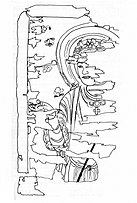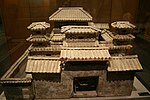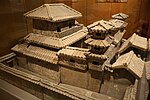Chinese Empire
This article may require copy editing for grammar, overcitation. (April 2024) |
This article may be too long to read and navigate comfortably. (April 2024) |
Chinese Empire
| |||||
|---|---|---|---|---|---|
| c. 221 BC–1912 | |||||
| Motto: None | |||||
Anthem:
| |||||
 The Chinese Empire at the fullest extent of control (in dark green) and sphere of influence (in light green). | |||||
| Status | Empire | ||||
| Capital | |||||
| Official languages | |||||
| Religion |
| ||||
Xuantong | |||||
| Chancellor | |||||
• 221–208 BC (first) | Li Si | ||||
• 1911–1912 (last) | Yikuang | ||||
| Legislature | Imperial Court | ||||
| History | |||||
| 230–221 BC | |||||
| 206–202 BC | |||||
| 581–618 | |||||
| 613–628 | |||||
| 1205–1279 | |||||
| 1368–1644 | |||||
| 1618–1683 | |||||
| 12 February 1912 | |||||
| Area | |||||
| All combined c.[1][2][3] | 15,000,000–15,500,000 km2 (5,800,000–6,000,000 sq mi) | ||||
| Population | |||||
• 1850 | 430,000,000 | ||||
| Currency | Ban Liang, Wu Zhu, Cash, Jiaochao, Tael, Paper money | ||||
| |||||
| Part of a series on the |
| History of China |
|---|
The Chinese Empire, also known as Imperial China, Empire of China[a], Celestial Empire, or simply China, was an imperial realm that spanned much from East, North, Central, South and Southeast Asia from the 1st century BC to the 20th century.[4]
Originally emerged as a loose collection of various Han Chinese-speaking entities during the Warring States period, the Qin's wars of unification brought most of the Huaxia realm into one single dynasty, establishing Qin as the first imperial dynasty in 221 BC, the year where the Chinese Empire was first established.[5][6] The Chinese Empire would continue to expand even after the collapse of the Qin dynasty, with the Han dynasty established itself with unprecedented expansion in the north, south and west.[7] It would be the Tang dynasty four centuries later that China really achieved the golden age of its imperial realm, where China became the world's most powerful economic, political and military power, a status which China would hold until the 19th century, along with its territory spanned from Central Asia, Tibet, Mongolia to Northeast Asia and partial Southeast Asia until being put to bed by the An Lushan rebellion.[8][9][10][11] The Chinese Empire marked its revival under the Mongol-based Yuan dynasty, in which China managed to incorporate Tibet and Mongolia into its inner territory. The Qing dynasty, founded three centuries after the fall of Yuan, laid ground to most of China's modern border today with its expansion into the north, central, south and southeast Asia.[12][13]
Following the 1911 Revolution, the Qing monarchy was abolished a year later, thus put an end to the centuries-old Chinese Empire following the imperial decree issuing abdication of Emperor Xuantong.[14] Yuan Shikai attempted to restore the Chinese Empire three years later, with himself as the Emperor, but it was put to bed by the lack of popular support for the restoration of the monarchy.[15]
History
Qin's unification of China and the birth of the Chinese Empire

The
Slowly and cautiously, Ying Zheng followed the plan as calculated. In 233 BC, the Qin launched a full-scale invasion of
At the same time, Qin also initiated war against
Under Qin Shi Huang, the empire didn't stop its expansion after unifying Huaxia. The Emperor took great interests in involving on conquering and pacifying the
Rise under Han
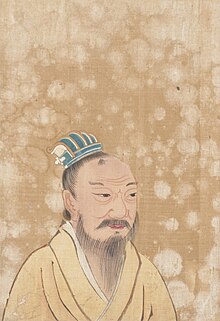

The Han dynasty marked a significant rise of China's territorial acquisition. Under the Han, China saw its territorial expansions such as moved north by conquering Gojoseon, going south by seizing Nanyue, and its westward expansion.[31] The growth of China's territorial size also enabled the country to become an imperial power.[32][33]
As the Han Chinese Empire was reaching peak, the empire suffered a major blow of its power when it was embroiled into a civil war when Wang Mang, originally chosen as the caretaker for the young Ruzi Ying, ended up renegading the role and proclaimed himself Emperor, establishing the short-lived Xin dynasty.[34][35][36][37] Although the Han dynasty would reclaim power under Emperor Guangwu, it greatly weakened the empire, allowing Goguryeo to free from Chinese control and almost lost Vietnam in process.[38][39][40] The stabilisation of the Han dynasty after civil war ushered a new era of prosperity for the empire, culminated into the high point under Emperor Zhang, where China restored its prestige and power in Asia and the ancient world.[41]
After Emperor Zhang's death, the Han Chinese Empire was subsequently weakened by political meddling and infighting from within, mainly from the
First interregnum: from the first Three Kingdoms to imperial surge under Sui
During this span, the Chinese Empire had become fragmented between three feudal factions: Cao Wei, Shu Han and Eastern Wu, both aimed to become the dominant power and thus fought a civil war that spanned for 60 years, became China's first imperial interregnum. However, it would be Sima Yan, who founded the Jin dynasty in Cao Wei, that would ultimately reunite proper China into one realm in 280 AD.[48] However, due to the longevity of the civil war, China had lost control of their territories Central Asia, thus only maintained its footholds in Korea and Vietnam in process. Emperor Wu sought to reform the system to make the already crumbled empire more efficient, but his work was undone when Yang Jun, a regent, seized the Emperor's will before his death, thus setting the stage for the subsequent disaster.[49]
Unhappy with the fact that
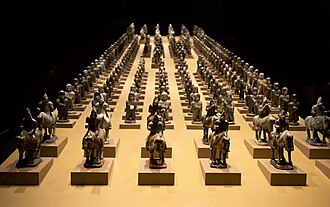
Meanwhile, the
The stalemate was put to an end in 581 AD by
Golden age under Tang
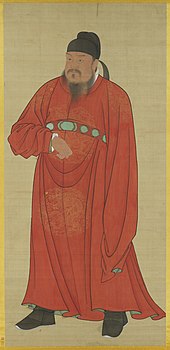
The Tang dynasty, established by Li Yuan in 618 AD, marked the height of the Chinese Empire with their unprecedented territorial acquisition and expansion, as well as establishing the Chinese Empire as the world's undisputed superpower for over a century.[66][67] Under the Tang, China successfully strengthened its control over Vietnam, reconquered Korea, took control over what would be today's Mongolia and Manchuria, as well as a part of Siberia, and, for the first time in 800 years, the empire managed to expand westward into the depth of Central Asia to as far as the Aral or Caspian Sea, and conquered Tibet for a brief of time.[68][69] Most notable of these campaigns had been the empire's reconquests of Korea and Central Asia.
Up toward Korea at the time, Goguryeo had emerged as China's most formidable threat, having successfully expelled four Sui invasions (and contributed to the collapse of the Sui dynasty). Learning from the past lessons, the Tang dynasty decentralised its military command to make its army more effective while allying with Silla, exploiting from Korea's internal divisions at the time.[70] While the first campaign in 645 had been unsuccessful, the Chinese were able to conquer Goguryeo again two decades later, this time by conquering Goguryeo's ally Baekje in 660 in the name of aiding its Silla ally.[71][72] Further aiding the Tang Chinese, Yeon Gaesomun, the dictator of Goguryeo who usurped the throne in 642 (which was used by the Tang as an excuse to launch an invasion), died in 666, leaving the state in perpetual crisis.[73][74][75][76] Exploiting from Goguryeo's divisions, Tang and Silla finally launched a full-scale invasion in 667, capitulating the Goguryeo state a year later.[77][78][79][73] Over 200,000 Goguryeo prisoners were taken by the Tang forces and sent to Chang'an.[80]
The Chinese Empire under Tang also achieved another great military feat by conquering Central Asia for the first time since the
Around the same time, Tang also managed to repel an invasion by the Tibetans in Songzhou and started to battle the Tibetans in process of the two's complicated relationship, and at one point even managed to occupy Lhasa for a brief short amount of time.[69][88] In 669, Emperor Gaozong launched the Battle of Dafei River against Tibet, but was defeated and lost control of Qinghai.[89] There were also intermarriages between Chinese and Tibetan nobilities and sometimes political alliances, notably between Songtsen Gampo and Princess Wencheng.[90]
During the golden age, the empire received numerous foreign dignitaries, all of these were portraited in
The brief Chinese control of Korea wasn't to last, as the disputes between China and Silla led to hostilities and wars in 670, which wasn't helped by public discontent as many Koreans were hostile to the Chinese; Silla, being a Korean Kingdom, had a mutual suspicion of their former ally, which ultimately resulted in a war.[92] The Chinese were ultimately expelled from most of the south of Taedong River of the Korean peninsula by Silla after six years of war, retaining only the northern half of it.[93][94][95][96][97]
The Arabs, which came from an Islamic civilisation in the West of Asia, started to wrestle control over Central Asia from the Chinese at the 8th century with the expansion of the Umayyad Caliphate, resulted in the Battle of Aksu in 717 AD, which the Chinese successfully repelled with the helps of its local protectorates under Tang control.[98] With the overthrown of the Umayyad, the newly-established Abbasid Caliphate resumed its activities to conquer Central Asia from the Chinese, resulted in the Battle of Talas in 751, a battle renowned for being the most devastating defeat ever for the Chinese in Central Asia due to the surprising betrayal by the local Turkic allies of the empire.[99][100]
Despite the shock setback to the Arabs in Central Asia at the time, it hadn't resulted in a complete weakening of the Chinese Empire as the Tang government remained formidable and powerful, and the empire still retained a large territorial control under one central government, which even their Arab rivals acknowledged.[101] It would be the infamous An Lushan rebellion a few years later (755 AD) that kickstarted the slow and devastating demise of the Tang Chinese Empire, after the renegade general An Lushan revolted against the Tang for his personal greed, founding the short-lived Yan dynasty; Tang would finally regain control with Shi Chaoyi committing suicide in 763 AD, but the damage was done.[102] The Chinese Empire's strength started to slowly fade, though in a gradual and prolonged process, notably with the loss of the Western Regions and part of Korea and Siberia to its Korean, Turkic, Arab, Mongol and Tibetan rivals.[103]: 140 : 157 While the empire managed to recover some of its power a century later to a point it could even launch a punitive expedition against the the Uyghur Khaganate in Mongolia in 840–847, its demise was completed with the devastating Huang Chao rebellion from 874 to 884.[104][105] This paved way for the eventual collapse of the Tang empire in 907 when Zhu Wen, a former general of Huang Chao who defected to Tang, manipulated the court before usurped the throne for himself.[106]
Second interregnum: from Five Dynasties and Ten Kingdoms to the second Three Kingdoms
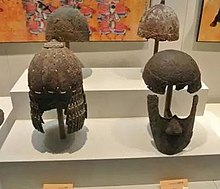
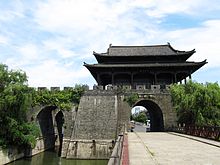
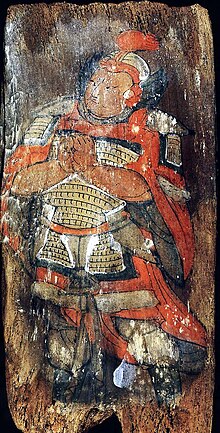
With the collapse of Tang, the Chinese Empire had lost almost every of its imperial domains controlled by the empire in the west and northern Asia. Zhu Wen quickly proclaimed himself as the Emperor Taizu, founding the Later Liang dynasty, but to his dismay, not all of the jiedushi (regional military governors) accepted his reign and thus formed their separate states, causing another interregnum.[107] During this era, these states rather governed themselves in autonomy or even independence from their rivals, even though not free from violent conflicts.[107] Nonetheless, perpetual instability inside China allowed the Vietnamese of Annam, at the time led by Ngô Quyền, to finally rebel against the ruling Southern Han dynasty, successfully seceded from China in 938, delivered a major blow to the Chinese.[108]
A new dynasty in the south, the Song dynasty, was founded in 960, and the dynasty slowly absorbed most of southern China into its territory and tried to reconquer Vietnam in 981, but ended in a huge failure due to infighting and malaria.[109][110] Meanwhile, the earlier-established Liao dynasty (and subsequently the Jin dynasty managed to retain control most of the north and became the most dominant power in there, forming the two Kingdoms period of uneasy coexistence.[111] In 1038, another rivalling power, the Western Xia, was established, forming the second Three Kingdoms era.[112]
-
Western Xia explosive caltrop
-
Jin wood structure (model).

During this time, the three Kingdoms flourished in their own ways as they consolidated their territories and managed their own affairs, while still occasionally fought each other for the supremacy of Chinese proper.[113][114] Economies and cultures also greatly prospered during this period of sporadic clashes between the three. During this time, these three dynasties produced different yet deeply intertwined parts of the Chinese culture, such as the Jin scholars put more emphasis on the work of northern Song scholar and poet Su Shi (1037–1101) than on Zhu Xi's (1130–1200) scholarship, which constituted the foundation of the Learning of the Way;[115] the Song dynasty marked a height in complex social and cultural organisations;[116] and the Western Xia with separate languages and customs.[117][118]
At the same time, the trio also sought to fight abroad conflicts as well, notably with the Liao/Jin and the Song. The Liao and subsequently Jin dynasties constantly fought wars against Goryeo for control of the northern plain with three separate invasions but with little success, which later converted into a series of sporadic conflicts.[119][120][121] Meanwhile, the Song turned south toward the newly-established Đại Việt, but before it could make war, Đại Việt struck first by invading Liangguang, becoming Vietnam's only dynasty to invade China proper, constituted into a bloody two years conflict that ended in a stalemate with little gain as well.[122][123][124] The stalemate situation would continue until the rise of the Mongol Empire in the 13th century.
Mongol conquest and the Yuan
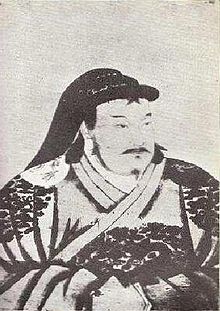

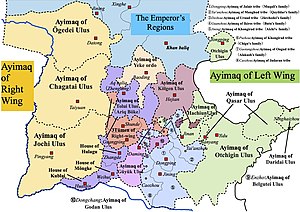
In the 13th century,
With the collapse of Western Xia and Jin, the Mongols turned to the Song and other smaller kingdoms in interior China such as Dali Kingdom. Dali would be conquered by the Mongols, which would go on to form the territory of modern-day Yunnan, albeit with some level of autonomy and partial independence under the Mongols by 1256.[135][136] However, its conquest of Song was far more difficult due to the Song's prolonged and often effective resistance; it took the Mongols 44 years to finally pacify the last remnants of the Song resistance in the battle of Yamen, where many members of the Song monarch and loyalists chose suicide while other fled to Đại Việt and Champa.[137] With the conclusion of the battle, the Yuan dynasty was officially proclaimed by Kublai Khan in 1271. Around the same time, the Mongols also took initiatives to conquer Korea, which would be completed a year before the Yuan dynasty was founded in mainland China with devastating impact.[138]
Kublai Khan became the first emperor of the newly-founded Yuan dynasty as Emperor Shizu, ending the second interregnum, and quickly established Sino-Mongol imperial control in the nation and would continue its expansionist legacies of the previous Chinese Empire, though this time with less success. Having conquered a large amount of land however, the Yuan dynasty was not able to exercise power to the fellow Mongol-controlled states in the west due to the already disintegrated nature of the Mongol Empire.[139][140] Also during this time, the Mongols only managed to achieve two major expansionist success; first occurred in Burma from 1277 to 1287, the Yuan conquest indirectly contributed to the collapse of the Pagan Kingdom although the Mongols never reached the capital;[141][142] the second was its conquest of Tibet and subsequent annexation, which marked for the first time Tibet was annexed to the Chinese Empire in the history (the Tang previously conquered Tibet but abandoned it shortly after without establishing full time control).[69][143]
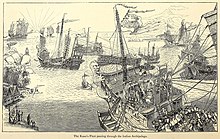
Yuan Chinese Empire's other campaigns, such as its bids to conquer Japan, Java and Vietnam, all ended in disaster. With Japan, the Yuan Chinese force had suffered from massive storms that killed thousands of the empire's troops in 1274 and 1281, resulted in the myth of kamikaze; while those surviving soldiers landed to mainland Japan were also quickly annihilated.[144][145] With Java, the Yuan Chinese force was unable to manipulate the Majapahit in a confusing and often comical effort, where the Yuan was unable to differentiate between friends and foe in Java.[146][147] However, the Yuan's biggest humiliation so far was the two failed invasions of Vietnam, given its geographical proximity between Vietnam and China unlike that of Japan and Java; the Yuan first invasion in 1283 to 1285 was met with ferocious resistance by the Vietnamese force and its Cham allies and due to unfamiliar environment in the hostile territory;[148][149] while the second one two years later ended in a naval catastrophe in Bạch Đằng in 1288 and most of the Yuan troops were unable to coordinate in this invasion.[150][151]
With the death of Kublai, the Yuan entered to a period of slow but irreversible decline, having spent efforts in trying to expand the Chinese Empire while at the same time struggle to contain increasing public discontents against the ruling elites, resulted in nationwide rebellions.[152] Ultimately, the dynasty would be toppled in 1368 by Zhu Yuanzhang, while the remnants of the Chingisid ruling monarch fled north, founding the Northern Yuan.
Transition under Ming

In 1368, the Ming dynasty was officially established in Nanjing by Zhu Yuanzhang, now Hongwu Emperor or Emperor Taizu of Ming, who reunited most of China proper but no longer in control of the other territories once controlled by the Yuan like Tibet, Mongolia, Manchuria and parts of Siberia. Under Hongwu's reign, the now reduced Chinese Empire had been tolerant to non-Han subjects, notably the Muslim population, in an attempt to win their loyalty.[153] The Emperor also undertook many reforms in his reign as well, notably by abolishing the position of chancellor,[154] drastically reduced the role of court eunuchs, and adopted draconian measures to address corruption.[155] He also established the Embroidered Uniform Guard, one of the best known secret police organizations in imperial China. In the 1380s and 1390s, a series of purges were launched to eliminate his high-ranked officials and generals; tens of thousands were executed.[156] At the same time, Hongwu also supported developing the economy such as agriculture, reduced taxes, incentivized the cultivation of new land, and established laws protecting peasants' property. He also confiscated land held by large estates and forbade private slavery. At the same time, he banned free movement in the empire and assigned hereditary occupational categories to households.[157] Through these measures, Zhu Yuanzhang attempted to rebuild a country that had been ravaged by war, limit and control its social groups, and instill orthodox values in his subjects,[158] eventually creating a strictly regimented society of self-sufficient farming communities.[159]
After the death of Hongwu, Jianwen Emperor embarked on an effort to pacify the remnants of the Yuan inside the empire, notably by completely incorporating Yunnan (ironically started by the Yuan itself) and northern campaigns against Uriankhai tribe and Buir Lake.[160] Yongle Emperor, the third Emperor of Ming China, exploited instability in Đại Ngu to finally invade and conquer the country in 1407, ushering the fourth Chinese domination of Vietnam, turning Vietnam into the Jiaozhi Province; around the same time he kept the campaigns against the Mongols in the north.[161][162] However, the Lam Sơn uprising in 1418 thwarted Chinese imperial rule inside Vietnam and greatly drained the empire's resource, ultimately resulted in Vietnam restoring independence ten years later and Chinese troops withdrew.[163] In the north, after decades of pacification, the Ming suffered an even greater setback with the capture of Emperor Yingzhong in 1449 by the Mongol tribes during a military campaign, resulted in the Tumu Crisis and almost caused the capitulation of Beijing.[164] These events resulted in Ming China becoming less expansionist and more defensive in nature, as well as concentrating on trade only.
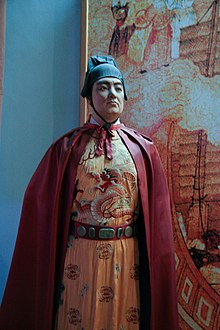

Around the same time under Yongle, the Chinese Empire flourished once more and reclaimed its status as the world's dominant power. Zheng He, a Hui navy Admiral of the dynasty, launched seven naval expeditions to facilitate trades and economic ties with other entities and states across the world at the time, both to serve the empire's commercial interests and also to fulfil his Hajj duty to Mecca.[153] Although occasionally fought wars, such as against the Sri Lankan kingdom of Kotte and Samudera, overall the general aim of the Ming had been to benefit every economic party involving and less than being militarily involved.[165] At domestic and regional affairs, the Ming largely refused to intervene, notably with how China didn't act when Vietnam conquered Champa in 1471 (although it pressured Vietnam to abort attempts to conquer Malacca Sultanate later on), unless it was related to their security of the empire.[166][167][168] While insurgencies still existed, mainly in Yunnan and later by the wokou pirates and Mongol rebels in northwest, the empire was mostly stable, enabled the empire's economy, culture, science and technology to develop, ushering a golden age during that span.[169]
Not until a century later, though, that the Ming Chinese Empire would eventually find itself involved in another large-scale war, this time in an effort to protect its Korean vassal from the Japanese invaders in 1592.[170] The Ming's interest was also to keep the war confined to the Korean peninsula and out of its own territory.[171] As for the result, the Chinese never brought more than 60–80,000 troops into the peninsula, though under the lead of General Li Rusong and Admiral Chen Lin, aided by the newest weapon technologies of the empire and the more capable Joseon navy under legendary admiral Yi Sun-sin, had proven to be a highly effective force to assist the largely inept and incompetent Joseon army at the time against the Japanese, before repelling the Japanese out of the peninsula in 1598, securing China's status as an empire.[172][173][174][175]
However, by intervening in Korea to aid its Joseon ally, Ming China had to pay a heavy price to keep
Rise and collapse under Qing

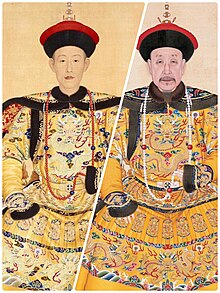
The Jurchens, descendants of the Jin people that were massacred en masse in the 13th century by the Mongols, had just founded the Qing dynasty in Shenyang in 1636 by Hong Taiji, replacing the Later Jin established earlier by Nurhaci. During this time, Later Jin launched a full-scale invasion to Ming China's most loyal tributary, Joseon, in 1627, which ended in victory for Later Jin.[181] Nonetheless, Joseon refused to abide and continued doing trades with the Ming, angered the newly-founded Qing rulers, who went on to invade again nine years later. This time, with the Ming clearly weakened and aided by two major Ming defectors, Kong Youde and Geng Zhongming (alongside a number of other Han Chinese troops), the Qing proceeded with the plan.[182][183] Joseon, once again, capitulated to the might of Qing and ultimately became a Qing vassal.[184]

Exploiting from the weakening of Ming, the Qing later maximised from it to ensure a smooth transition in 1644, when the Qing defeated Li Zicheng with the help of yet another Ming defector, Wu Sangui.[185] This led to the official establishment of the Qing Chinese Empire, with Fulin crowned as Shunzi Emperor.[186] Under Shunzhi, the Qing restored the old order, conquered most of the Ming territory and managed to defeat the last Ming resistances in the south and notably, in Taiwan.[187] Around the same time in the north, the Tsardom of Russia, a European inland state on the making of an empire, had also began to expand southward, culminated into the invasion of the Manchu heartland by the 1650s, and defeated the Chinese in the first battle.[188][189] Growing Russian threat and difficulties fighting it forced the Qing Chinese to dedicate troops to the north and even employed soldiers of the former Tungning Kingdom, ultimately managed to defeat the Russians in 1689, resulted in the Treaty of Nerchinsk and therefore securing the integrity of Manchuria under Qing's hand.
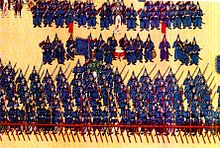
With its northern border secured from a hostile European power, the Qing Chinese Empire experienced a
The demise of the Chinese Empire

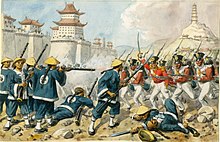
As the Chinese struggled to expand further inland, the empire faced a new threat from afar. European naval empires had begun to dominate and, with China became more and more isolationist due to the
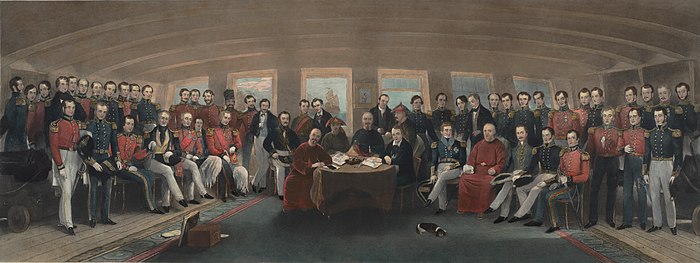
The situation didn't improve much for China after the death of Daoguang Emperor in 1850, with Xianfeng Emperor (the last absolutist Emperor of China) struggled to cope with the earlier defeat to the British in 1842; growing hostilities against European subjects in China ignited fervour for war against China once more among European empires, ultimately led to the Second Opium War in 1856.[207]: 501 This time around, with France joined the party, the Anglo-French coalition again defeated China, causing Chinese officials to realise it was not just a defeat but a looming national crisis.[208] At the same time, the Chinese Empire was also forced to sign another treaty with the now-transformed Russian Empire in the north in 1858, resulted in Manchuria partitioned into two between the two empires, ultimately resulted in China losing the left bank of the Amur River to Russia.[209] The deterioration of China was further ratified with the Convention of Peking.
Looming national crisis for China didn't stop within the east coast of the empire where most of the fightings took place. In the west, the British Empire had managed to conquer all of the Indian subcontinent and established its rule, and during this span, the British started turning their attention toward Tibet, which was already governed by the Qing Chinese.[210] The British attention to Tibet was drawn by the alarming rate of Russian expansionism in Central Asia; exploiting from the weakening of the Chinese Empire, the Russians slowly conquered most of Central Asia, including territories nominally under Qing control in today's East Kazakhstan, Kyrgyzstan and Tajikistan, with the Qing Chinese largely powerless to protect its outer Central Asian domain.[211] By this point, China's control of Xinjiang (akin to Tibet), a region pacified by China a century ago, was put under siege by growing Russian assertiveness.
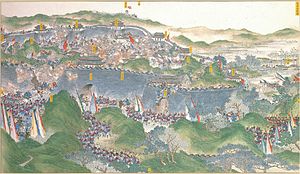
As well as dealing with increasing foreign encroachment into the mainland, the Chinese imperial army had to face numerous rebellions in the aftermath of their defeat to the British. The Taiping Rebellion in 1850 forced the Qing to send troops to suppress in 14 years. The Taiping rebellion was the biggest and most devastating rebellion in the 19th century due to the size of the involving forces, and the destruction left behind;[212][213] over thirty million people fled the conquered regions to foreign settlements or other parts of China while other thirty million people were killed or died of non-combat issues, causing a severe depopulation inside the empire.[214] In the aftermath of the rebellion, the empire had become increasingly decentralised both politically, economically, socially and militarily.[215][216][217] Outside the devastating rebellion caused by the Christian-led Taiping Heavenly Kingdom, the Qing Chinese Empire had to also face rebellion from the ethnic Miao in Guizhou, the Red Turban rebellion by Tiandihui, the uprising by the ethnic Hui Muslims in the northwest, and the Muslim-led Panthay Rebellion in the southwest as well.[218][219][220][221] While the Qing would also ultimately triumph against these rebellions, its impact was heavy as the empire's treasury and economy suffered burden after burden, making China vulnerable to growing foreign strengths.

With the threat to the empire's survival soared, various self-strengthening movements, under Empress Dowager Cixi's supervision, were established by Prince Gong in an attempt to reform and strengthen the declining Chinese Empire, allowed the empire to extend its longevity for a few decades next; however, corruption and mismanagement, as well as ultraconservatism in the empire's officials prevented the reforms from ever making a greater impact, continued to undermine the empire's capability.[222][223][224][225]
In spite of the controversies surrounding reforms and corruption inside it, the reform movements proved to be crucial when the empire succeeded in quashing the rebellions in Xinjiang, notably when how the empire managed to defeat the rebellious state of Yettishar of Yakub Beg, earned recognition from the British.[226][227] The empire also put up a decent display in the subsequent Ili crisis toward the Imperial Russian Army, ultimately able to secure the Ili region back to China in 1881 via the Treaty of Saint Petersburg; the Russians also admitted the Chinese put a fair display of military threat in this situation after observing Imperial Chinese Army's military buildup in the region.[228][229][230][231] Most notable improvement of the Imperial Chinese Army during this era was their performance in the 1884 Sino-French War, where the Chinese were more capable than their previously poor shows against the British in the Opium Wars, put up a strong resistance and even scored several major victories against French troops in Vietnam; while the war didn't end in Qing China's fervour, it contributed to the collapse of the Jules Ferry government (via Tonkin Affair).[232][233][234]
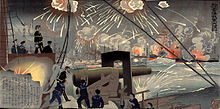
But as China was thought to have slowly recovered their prestige, the empire was dealt a major blow in Korea a decade later when Japan decided to invade Korea in 1894.[235] The rivalling Empire of Japan, modernised decades earlier with greater effectiveness, defeated the larger but not cohesive Chinese army that was considered a major geopolitical shock at the time, with the core of Asian power for the first time shifted from China to Japan.[236] To make it worse, the Treaty of Shimonoseki forced China to relinquish its influence over Korea and ceded Taiwan to Japan.[237] This humiliation put to bed the Self-Strengthening Movement and triggered a nationwide crisis due to rampant corruption and mismanagement within the empire. Widespread resentment against foreigners culminated into the Boxer Rebellion in 1899, in which the Qing Chinese Empire tacitly allowed the rebellion to occur with hopes to regain the last prestige for the decaying empire; it took two years before the rebellion was crushed by a coalition.[238][239] During the same span, the Russian army also launched an invasion to Manchuria, the heartland of the ruling Qing monarch.
By this point, the damage was done. Another frantic attempt to rescue and salvage the reforms
Xinhai Revolution and the end of imperial rule


Nonetheless, public discontent against imperial rule had already reached peak. Resentment toward the empire's failure to ward off foreign threats and the loss of prestige presented a fertile ground for revolutionary ideas to emerge across China, as the empire struggled to implement reforms. Around the same time, Kang Youwei and Liang Qichao formed the Emperor Protection Society in an attempt to restore the emperor, but others, such as Sun Yat-sen organized revolutionary groups to overthrow the dynasty rather than reform it.[245] With the ascension of Puyi as Xuantong Emperor in 1908, Prince Chun was appointed as regent in a need to carry further reforms.
The outbreak of the 1906 and 1907 famine was also a major contributor to the revolution due to inadequate perpetration by the imperial government in handling the relief efforts for the regions hit by it.[246][247] Although the imperial government formally admitted that it needed relief efforts from abroad to handle the crisis and later collaborated with the foreigners, mainly the Americans, to do so, over 20–25 million people had perished due to the famine.[248][249][250][251] The horrifying impact of the famine, still, left the final straw to the population due to the high number of fatalities.[247]
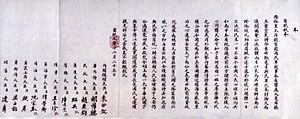
On 27 April 1911, the
With this, Puyi was forced to abdicate from the throne on 12 February 1912. This confirmed the Republic of China as the official successor of the Qing dynasty as well as the Chinese Empire as a whole.[255][256][257] With this proclaimation, the Chinese Empire officially ceased to exist after 2,132 years.[258]
Territory
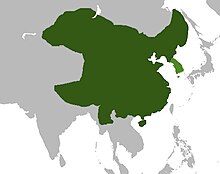

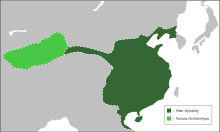
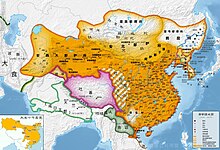

Due to the fluid nature of the empire given it changed constantly under various dynasties in charge of China, its territorial size is often not correctly calculated or largely ignored.[259] However, by all combined factors that dated back from various dynasties and territorial control, the empire stood between 15,000,000 square kilometers (5,800,000 sq mi) to 15,500,000 square kilometers (6,000,000 sq mi), ultimately made the Chinese Empire the fourth largest empire in the world's history, only behind the British, Mongol and Russian counterparts, as well as the third largest inland empire in the history behind the Mongol and Russian empires.[1][2] More than 100 ethnic people lived inside the empire, with the majority of the empire's population largely inhabited in the east coast. The Han Chinese formed the largest ethnic group throughout the empire's history respectively, which had also served as the dominant elite population regardless of which dynasties.[260]
Geography
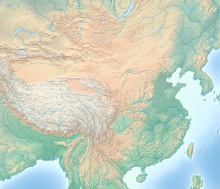
The bulk of the empire's administration had always been on the eastern portion, which formed the
A notable feature of China was the massive networks of rivers, especially the two traditional and historically important rivers, which played a significant and crucial role in the history of China.[261] It was from this river basin that a number of China's imperial capitals were established within until the rise of Beijing during the Yuan rule, which was the only capital in the empire not to be founded on any major river basin; ironically, Beijing was the first capital of the empire, established during the Qin as Jicheng.
Territorial evolution
Over the course of Chinese history, the empire's territorial control has also been fluid due to dynastic and structural changes. This historical pattern, however, only gained attention today in comparison to the
Under the Qin dynasty, the Chinese expanded north and southward, clashing with the nomadic, Korean and Yue peoples, acquiring most in the south while chasing away the threat from Xiongnu nomads of the north.[23] The Han dynasty subsequently inherited from it and started to expand even further, both in the north, east, south and west; during this time, China managed to annex what would be northern Vietnam and Korea today, establishing the Four Commanderies of Han in Korea as well as the Chinese rule over Vietnam; the empire also took a great effort to look forward to the west, where the Chinese entered Central Asia for the first time.[31][32]
After the collapse of Han, China entered a period of civil wars before it was unified under the Sui dynasty, but lost control of both Korea and Central Asia in process, with only northern Vietnam retained; the successor dynasty, Tang, marked the golden age of the Chinese Empire with an unprecedented expansion that saw the Chinese not just managed to reconquer Korea but even it marked their successful conquest of Central Asia.[78][79][87][83] China also marked their first entrance to Tibet, though it was temporary.[69]
After the collapse of Tang, it wasn't until the Yuan dynasty that the empire marked its revival in expansionist fortune. The Yuan managed to conquer Burma (albeit partially) for the first time, seizing Korea after a series of hard-fought campaigns, as well as annexed Tibet into China for the first time ever.[141][138] Mongolia and a vast portion of Siberia were also under the direct control of the Yuan as well.
With the collapse of the Yuan, the Ming dynasty tried to reconquer some lands previously belong to Yuan, but their failures in Vietnam and Mongolia later on meant that the empire would not expand their territory until its own collapse.[163][164] Rather, it would be the Qing dynasty that laid ground to most of China's modern boundary, by annexing Mongolia, expanding to the Sakhalin island, as well as conquering parts of Central Asia and Tibet to the domain and for the first time, Taiwan was merged into the Chinese territory.[191][193][196] The Chinese also attempted to fight the Sikhs and Nepalis in the Kashmir and Himalayan mountains, the Burmese and Vietnamese in the south, and the Russians in the north, for territorial gains, but with little success.
Demography

As China only began to make serious censuses over the population in 1740, the size of China's population had been a matter of debate and different methods have been used to figure the population size.[263][264][265]
By the time of the Qin dynasty, China's population was believed to be about 40 million when the nation was first unified, but due to brutal reign, disease, famine and harsh punishment of Qin Shi Huang, the population dropped to 18 million by the end of the dynasty.[266] By the time of the Han, the population was thought to have experienced a massive recovery from the huge demographic loss under the Qin to reach a solid 60 million, one of the most populous nations at the ancient world.[264] However, the collapse of Han saw the nation plunged to famine, wars and diseases, preventing the population from growing stably.[265]
The Tang dynasty's population saw yet another recovery, but the population didn't surpass that of 55 million people by 754 CE, before China fell to an era of civil wars once Tang dynasty collapsed.[264] The Song dynasty in the south of China later, stood about 46 million during the year of 1103, whereas their rivals Liao and Western Xia's demographics were not mentioned due to lack of possible data.[264] Under the Yuan, the population sandwiched between 55–60 million people, which had been stabilised during the time of the Ming as well.[264]
New crops from the ‘New World’ that had come to Asia from the Americas via the Spanish colonizers (including potatoes and corn) led to a rapid increase in population in China under the Ming, and by 1850 (under Qing rule), China had a population about 410–430 million people, making it the second most populous nation in the world at the time after the British Empire.[264][265] This huge population boom was only stopped due to the subsequent rebellions and wars, but it also triggered the migration of Chinese people, mostly Han Chinese, out of their territory to elsewhere, forming the largest Asian diaspora community that stands to even today.[265]
Languages
Due to the large territorial size and longevity of the empire, China had also had a lot of different languages. Still, the main speaking language of the Chinese Imperial Court is Chinese, which had also served as the lingua franca for all of the minorities inside the empire, and had also been conducted in Imperial examination throughout the history.[267]
Outside of Chinese, other languages were also spoken inside the empire, depending on which circumstances. The
Outside these languages, other languages such as
Religion
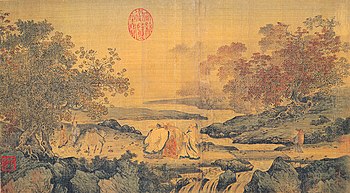


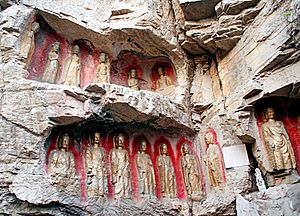

Under the imperial rule, the Imperial Court mainly promoted
Confucianism
Daoism
Taoism, believed to be founded by Laozi, also played a significant role as one of the empire's official state religions.[274] It had played a major key role on the development of the country's social and cultural thoughts, as well as its guidance in politics and warfare.[275][276] Taoism had been promoted by the Han dynasty and, like Confucianism, maintained an unquestioned position and got patronised by the empire.
Buddhism
Initially, Buddhism was viewed with scepticism before it later managed to co-exist, albeit under uneasy circumstances. Buddhists in China suffered persecution four times, first happened during the first Chinese interregnum when Emperor Taiwu of Northern Wei blamed Buddhists for helping the Xiongnu;[281] while the second was a less severe one under Emperor Wu of Northern Zhou, where monasteries and temples were destroyed but its followers were spared.[282]
In 845, nearly 250 years after peaceful co-existence, Buddhists suffered the worst persecution so far, when
After this dark era, Buddhism would ultimately survive and continue to play a role in Chinese society, with other forms of Buddhism subsequently promoted by various imperial governments. One such Buddhist practise,
Another major form of Buddhism inside the empire was
Islam

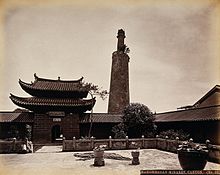
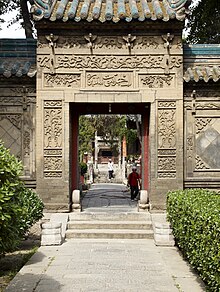
Islam was first spread to China during the Tang government, thought to be from the mission of Sa'd ibn Abi Waqqas during the reign of Emperor Gaozong of Tang.[295][296] Ever since then, Islam had maintained a rather unique position on the Chinese Empire, ranged between various sects and ethnic groups, which provided a fascinating range of treatment. Sunni Islam was the largest Muslim denomination in the empire, while Sufism gained some level of followers and Shia Islam was practised only by the Tajik subjects.[297]
A sustainable wave of Arab, Persian and Turkic merchants movement to China via the Silk Road during the Tang dynasty allowed Islam to flourish inside the empire, many of these people would intermarry with the Han locals and create a unique Muslim group called the Hui, who were deeply Chinese by culture, but Islam by possession.[298] The development of Islam in China would be escalated by China's military conflicts with the Arab Caliphates in the west for control in Central Asia, including the conversion to Islam by the Turkic population after the Battle of Talas.[299] Muslims started to gain a more prominent role in the Song government as they were invited to settle under its realm as a buffer against the Sinicised Liao rival in the north.[300][301] The Yuan government allowed Islam to escalate their development in China, during which many Muslims of Arab, Persian and Central Asian heritages were invited to China proper.[302] Many of them became renowned scientists and technicians, while others worked as governors, officials and politicians.[303][304]
When the Ming dynasty was founded, Hongwu Emperor had been supported by the Muslim nobility and several Muslim generals like Lan Yu and Hu Dahai had served him against the Yuan.[305] It was during the Ming era that Islam truly established a major foothold inside the empire, with Hongwu himself ordered the building of several mosques in southern China, and wrote a 100 character praise on Islam, God and Muhammad.[306] The Muslim population had also become so deeply integrated to the empire that many would adopt Chinese names and customs during that span; many of them would also later become Generals and eunuchs, as well as other government officials, or either successful merchants of the empire.[307][308][309] The blend with the Han Chinese culture also led to the unique creation of Chinese Islamic architecture and Chinese Islamic cuisine, which stayed Islamic by nature but greatly influenced by the Chinese culture, as well as the development of Han Kitab.[306] Many of them would fight for the Ming dynasty when the Manchu-led Qing conquered China proper and continued their insurgency until the Qing fully gained control of China by 1683.[310][311]
Under the Qing government, the Qing viewed Muslims depending on circumstances as the empire expanded westward, as the empire started to experience a new groups of Muslims from Central Asia, most of them being Turkic and turned Muslims since the 10th century. Muslims still served the new dynasty as part of the Green Standard Army corps and some even gained fame for their military performance.[312] The Muslims even helped the Qing government to put down the two Dungan revolts as well as reconquering Xinjiang.[313] Also, some of them also put up their resistance against foreign invaders.[226][227]
Persecution
Nonetheless, despite neat treatment by the imperial government, Muslims weren't fully spared from persecution. The Huang Chao rebellion in the 9th century resulted in a bloody Guangzhou massacre, during which he massacred thousands of people, many of them being Muslims, by the rebels.[314][315][316] Under the Yuan, the Muslim subjects suffered from a number of edicts banning them from practising their religion; the repression became severe in the waning days of the dynasty and played a key role behind the Muslim supports for Zhu Yuanzhang's rebellion.[317]
Persecution against Muslims was intensified under the Qing monarch, with Kangxi Emperor blamed the Muslims to incite anti-Muslim rebellions among the Mongols.[318] In 1756, shortly after pacifying Xinjiang from the Dzungar Khanate, the Turkic-led Afaqi Khoja revolts broke out against the Qing, before it was ruthlessly put down.[319] In 1765, a major rebellion broke out by the Turkic population there when a government official gang-raped a Turkic woman there.[320][321][322] At the 19th century, two devastating Dungan revolts by the Hui Muslim population, mainly aimed on grievances against injustices caused by various sects and government officials led to the deaths of millions, yet the government accused them of being connected to the Taiping Rebellion.[323] The Panthay Rebellion by Sultan Du Wenxiu also specifically claimed against the Qing government, accusing the Qing of corruption, leading to a massive campaign of bombardment and massacres of the Yunnanese Muslim population by government troops, save for those that surrendered to the imperial army.[324]

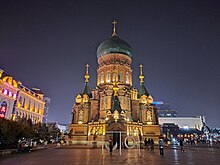
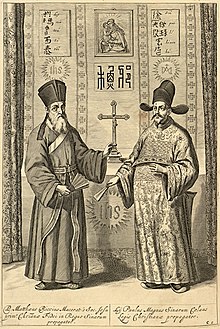
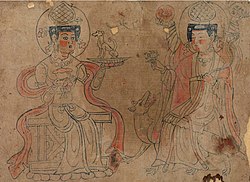
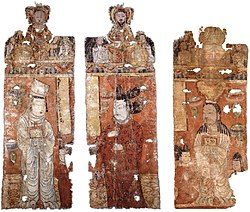
Christianity
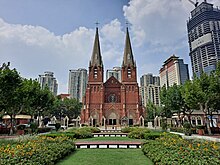
Christianity had a long presence in the empire, first established during the Tang reign. The first recorded Christian mission to China was led by the Syriac monk known in Chinese as Alopen. Alopen's mission arrived in the Chinese capital Chang'an in 635, during the reign of Emperor Taizong. Taizong extended official tolerance to the mission and invited the Christians to translate their sacred works for the imperial library. This tolerance was followed by many of Taizong's successors, allowing the Church of the East to thrive in China for over 200 years and solidified the Church's presence.[325][326] This also led to the blending of Confucianism and other Chinese beliefs into their practise.[327] Many Christian communities were found across the empire and some even assisted the Tang government in crushing the An Lushan rebellion, namely Bactrian Priest Yisi of Balkh, which he was rewarded.[328][329][330][331][332][333]
The Christian community suffered a major blow in the 9th century, when Emperor Wuzong of Tang issued a decree in 845 that persecuted all other religions inside its realm. While this edict targeted Buddhists, it also hit Christians especially hard due to the imperial government characterising Christianity as part of Buddhist practise, resulted in the deaths of an unknown number of followers and many churches and monasteries destroyed.[334] However, while Buddhism would eventually recover and survive, the Nestorian Church of China would not.[335][336][337]
The Church would mark a return to China at the 13th century under the Yuan rule, due to their cooperation with the Mongols in
Although Christianity was severely weakened by the 14th century in China, however, inter-religious relations still existed under the Ming, but this time with the
Christianity would suffer a major blow following the
The persecution would only end with the Opium Wars, where Christians were no longer persecuted in China; during this era, a major Christian-led rebellion broke out under the self-proclaimed leader Hong Xiuquan which was later suppressed by the government; the Boxer Rebellion almost reversed the development in process.[349] In the final years, the Qing government allowed French missionaries to enter Tibet and converted the locals to Christianity; this was intercepted as a betrayal by the Tibetan Lamas (which was the source of support for the Qing government's legitimacy) for violating their land and belief, causing a major unrest in 1905, which was only suppressed by the imperial army.[350]
Other religions
Zoroastrianism first arrived to China during the 6th century CE, was the religion of the Hu people. Unique among all religious belief, Zoroastrianism didn't spread out but instead confined to only one people.[352][353] The belief suffered from a violent persecution by the Tang government at the 9th century, which had resulted in its disappearance from the Chinese territory.[283]
Another Persian religion, Manichaeism, also entered China, where it was localised as Chinese Manichaeism.[354] It suffered from a similar repression at the 9th century but managed to survive.[283][355]
Judaism, practised among the Jewish population, first arrived around an unknown timeline, possibly within the 9th century, while some argued it dated back to the Han dynasty.[356][357] The Kaifeng Jews were one of such Jewish communities to have made their permanent stay in China.
Shamanism and Tengrism were both popular beliefs of the nomadic tribes in the north of the empire, mainly from the Mongol and various Turkic population, and was also practised by the empire's Korean subjects.[358][359][360]
Government and administration
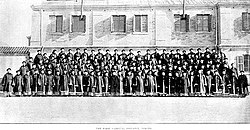
The empire's function of the government had been historically operated under the form of an absolute monarchy, where the Emperor ruled by edicts and decrees, regardless of which dynasties in power.[361] By 1901, however, the empire was switching into a rather different form of government, modelled after that of Japan in a series of reforms that gave a little power of autonomy for local officials and decentralisation of the bureaucratic system.[240][241] However, the Emperor remained formidable with the power wielded.
Unique among all the empires across the world, the Chinese Empire was characterised by dynastic changes, but retained its imperial nature, thus explained for its longevity and a major distinction compared to others like the
Emperor of China
First created under
In 1901, as part of the late reforms, the power of the emperor was slowly reduced, in an attempt to model the empire after that of Japan at the time.[365] However, these reforms were aborted with the outbreak of the 1911 Revolution.
Imperial Court
In the imperial government, a general theme inside it was the divisions of the court into various ministries throughout the history. In the Qin and Han monarchies, the system was the
The role of Chancellor (also known as Prime Minister) in the empire was largely ceremonial under the imperial government, although it varied over time under which dynasties stood in power.[369][370][371] The position was abolished under the Ming government, but subsequently revived in the waning years of the Qing government as part of a series of radical reforms.[370]
Local administration
Begun with the Qin, the government set up the prefecture and county system, with a very far-reaching influence.[372] The system was later revised into the provincial system under the Han, with the governor in charge of each province, the grand administrator under a commanderie, and the perfect in a county; it was modified under the Yuan, which would set up the standard practise of local authorities that continued to be run by the Ming and Qing governments.[373]
Judicial system
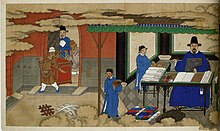

Due to the empire's autocratic nature, a judicial system was not established separately for a long time until the 20th century. Instead, the government ruled the empire by imperial edicts and decrees. Nonetheless, several laws were enacted during its existence.
Under the Qin dynasty, the Legalist code was implemented across the empire with severe punishments even to the smallest crimes.[374][375][376][377] Legalism would survive after the fall of Qin, but its harsh nature was replaced by Confucian values as the Han officials realised the need to make an effective government without brutalising the already devastated population.[378]
The Tang government introduced the
Penal law in the Chinese Empire had been modified or changed throughout existence as well. While the Qin and Han governments did issue several penal laws, none of these were sophisticated and often difficult to understand. It was the Sui dynasty that the Kaihuang Code become the first fully issued penal law of the empire, serving as the basis for the Tang's Five Punishments and Ten Abominations.[381][382][383] All of the subsequent dynasties such as the Song, Liao, Yuan, Ming and Qing all applied the Tang penal code, but with variations of their own.
Civil law in the empire differed greatly from that of their Western imperial counterparts that the civil law stood below that of the criminal law. From the provisions of the penal code, magistrates could either derive principles of civil law either directly, if a matter was stated in the penal code (such as matters regarding debt and usury, dealings with land, the borrowing and pledging of property, and the sale of goods in markets), or indirectly reading into a criminal statute a basis for a private civil suit.[384]
Use of property was divided into topsoil (
In 1901, as part of the radical reforms aimed at improving the empire's efficiency, the government started designing a new code and judicial system. Local and regional police forces were organized, with model prisons opened.[387][388]
Military

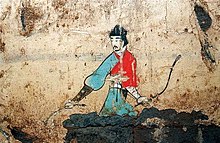
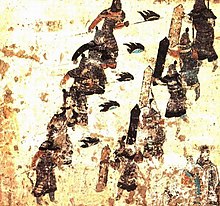
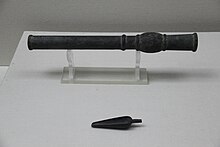
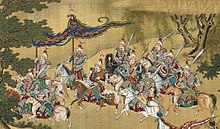
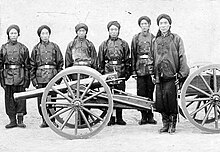
Due to its historical existence and long boundary, the Chinese Empire had always been forced to maintain a large, standing army, either for conquests or to safeguard its border.
Imperial Chinese Army
Under the Qin dynasty, the first Imperial Army was founded. The empire organised its military force via forcible conscription from the prisoners of other defeated states.[389] At the same time, the empire was also quick to adapt with the Xiongnu's horsemen tactics, inventing the cavalry, fighting alongside with the infantry, chariot and archer.[389] The Qin especially invented in the archery force, which would become the bulk of the empire in the ancient era.[390] The Han dynasty largely followed the development but further expanded and reorganised some, such as conscription, tactics and trainings, while the role of the cavalry slowly increased as the chariot's position began to diminish.[391][392][393][394] Armour, crossbows and swords were also paid special attention as it served as the core military designs and weapon supplies for the imperial troops.[395][396][397] Constant wars during the first interregnum (220–581) allowed military industry to develop and thus a number of new weapons and tactics, as well as improvising the old system to suit with the new situation. The Shu Han formed the Flying Army full of mounted archers, and the importance of crossbow troops became unquestioned during the time.[398][399] Armoury became a norm while catapult got upgrade under Ma Jun, a Cao Wei engineer.[400] The Sui would largely inherit it, although the Sui dynasty failed to maximise from these developments.
The Tang government, which resided in a golden age, witnessed the empire's military development to its zenith, making China the unquestioned superpower at the time. During this era, the Chinese developed a recruitment system called "
The Yuan brought a new development by mixing military and civilian duties into the imperial army while segregating other groups, mainly based on ethnic and familial background.
The Qing government developed the

The Imperial Navy, first developed during the Qin but didn't receive much attention even during the Han and Tang, was emphasised for the first time under the Song, although it fell into disuse in the aftermath of the failed
The Ming's reduction of naval activities later on didn't stop the imperial navy from taking part of other major military conflicts. The imperial navy managed to defeat the Portuguese forces invading Malacca Sultanate and inflicted heavy damages on the Portuguese navy in Tunmen and Sincouwaan.[441] The imperial navy was also dispatched to help their Korean allies fighting off the Japanese invasions during the 1590s; this naval conflict was a major success for the imperial navy. Notably, Chen Lin, a decorated Admiral at the time, played a pivotal role alongside Korea's national hero, Admiral Yi Sun-sin, in expelling Japanese troops out of the peninsula.[442] At the early 17th century, the Chinese navy defeated the Dutch in a prolonged conflict that ended in the 1670s.[443][444][445]
The Qing government maximised from the use of the navy left behind by the Ming when they began their operation to conquer Taiwan. Admiral Shi Lang took the lead in the Battle of Penghu, which ended with the Qing victory and collapse of Tungning state.[446] After that, the sea ban prevented the navy from growing, contributed greatly to the Qing's defeat in the Opium Wars. As for the result, the modern imperial navy was established in 1875 and with that, the navy was able to prove some of their worth during the Sino-French War, with one notable victory in Tamsui, although with a great cost and disunity between officials remained.[447] Disunity between naval officials proved to be the catalyst behind the navy's defeat to Japan a decade later when China's Beiyang Fleet was annihilated by the Japanese in the Battle of the Yalu River.[236] Late reforms proved insignificant and the imperial navy would later be absorbed into the new Republic in 1912.
Imperial Chinese Air Force
The Air Force, created during the Qing rule, didn't play a major role due to its short time span. The imperial government had established aircraft operations at the Beijing Nanyuan airfield in 1909, and started training the first corps of pilots there. Once the empire was abolished in 1912 however, the air force was absorbed by the new republic to form the Republic of China Air Force.
Economy

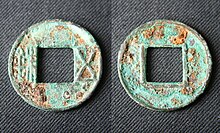
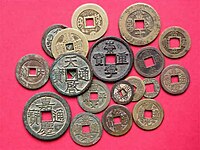
Because of China's historical role and location, the economy of the Chinese Empire was also deeply reflected from this heritage, with the Chinese Empire long stood as one of the richest and most developed economies.[448][449][450] One notable feature of the empire's economic policies is it had also been deeply intertwined with the idea of which the ultimate goal of a state was consolidation and extension of the ruler's power, and the way to reach it was to get rich resources of revenues by making the productive classes prosperous, a concept later followed by various inland empires such as the Russian and Ottoman Empires and also influenced economic development thoughts later on.

The Qin government, which formed the Chinese Empire, promulgated the empire's first unified economic system under the very strict
In 119 BCE the central government introduced the wushu (五銖) coin weighing 3.2 g (0.11 oz), and by 113 BCE this became the only legally accepted coin in the empire, the government having outlawed private mints; this would become the standard currency of the empire until the Tang dynasty took power centuries later.[458] The economy suffered a hiatus in the aftermath of the collapse of the Han dynasty and feudal kingdoms took responsibility with their own economies, such as taxes and labours, to a point they had to import Xiongnu labours to alleviate from shortages; nonetheless, internal problems hindered the economy greatly and prevented the economy from developing to a more proper market, exchange economy until the Sui dynasty arrived in 581.[459][460]
The Sui government laid ground for development of the new economy after unifying China, such as imposing equal-field system, charged three "Shi" of grain each year, and peasants were required to perform 20 days of labour for the state per year, but those over 50 could instead pay a small fee.[461][462] The Tang developed from the Sui institutions to achieve the golden age, where taxes, labour requirements and prices were put into an acceptable level and carefully divided between household, whereas productivity standard also soared.[461][463][464] However, the economy again suffered from another devastating rebellion, this time by An Lushan, leading to the economic shift from the north to the south, and a massive reorganisation of the economy such as privatisation and annual taxes.[465][466] With the Tang dynasty's collapse and triggering of the second interregnum, the northern part was left devastated while the south recovered from the devastating Huang Chao rebellion to become a mercantile economy.[461]
The economy of the Liao and Song dynasties later on also exhibited significant differences from the region they controlled. With the Liao dynasty, the economy was heavily influenced by nomadic economy, maintained throughout trading of stocks, and in a lesser extent, fishing and hunting, with farming and handicrafts emerged aftermath with varieties of their products from it due to locating in the north.[467][468] The Song, meanwhile, developed a far more sophisticated economy and witnessed the first full involvement of private business with the withdrawal of the central government from managing the economy thanked for their location in the south.[469] The merchants under Song also gained more prominence and respect, whereas agriculture and other industries also improved under the Song.[470][471]
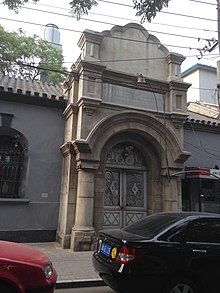
The Yuan rule saw an explosion of Chinese economy and expanded the Grand Canal in Khanbaliq (now Beijing), a key reason that allowed Beijing to remain capital of China today.[472] The government also issued first paper money known as Chao, but it was reserved under imperial control; around the same time, the imperial government also introduced high taxes.[473][474]
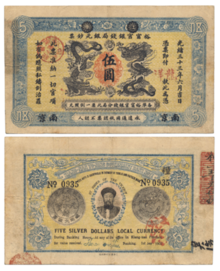
The Ming rule saw China experienced for the first time the
In general, while the empire's economy had experienced up-and-down as well as golden ages, most of Chinese population were peasants or even merchants, while a small portion of people became wealthy landowners; more successful businessmen often became government officials at some extent.[486][449] By the late 19th century, under the experience with Western-style market economy, a new group of elites and middle-class also emerged.[449][486]
Culture
Having possessed one of the world's oldest and most developed culture, the Chinese Empire had a wide range of their cultural and historical heritages, reflected from the empire's longevity and historical conquests.
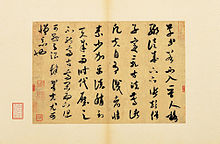
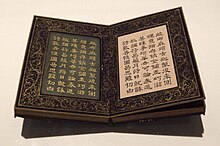
Education

Establishment of the
A string of losses to European empires from the 1840s onward forced the empire to embark on a modernisation effort, founding the
In addition, private education also existed in many form in the empire throughout history.[488]
Calligraphy
Renowned as Shūfǎ (書法/书法), literally "the way/method/law of writing", Chinese calligraphy had a great impact on Chinese society.
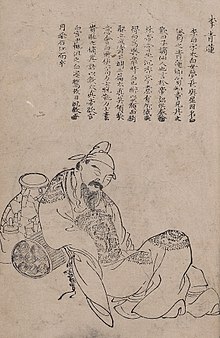
Literature
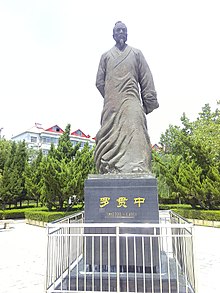
Classic Chinese Novels, about greatest Chinese literature masterpieces, which were Romance of the Three Kingdoms, Water Margin, Journey to the West, and The Plum in the Golden Vase of the Ming dynasty and Dream of the Red Chamber (The Story of the Stone) and The Scholars of the Qing dynasty, all had long been some of the most well-known literature products from the empire and had been among China's most revered.[494] Among them, the Romance of the Three Kingdoms was the most popular of all and had also made impact outside the empire, making Luo Guanzhong (the author of the Romance) the most renowned imperial Chinese writer in the history.[495][496]
In early Qin and Han rule, a distinctively descriptive and erudite

By the mid-19th century, contact with Western literature led to a new exposure of translating Western works and development of new
Music and arts
Music

Established under the Qin dynasty as the
The oldest extant written Chinese music is "Youlan" (幽蘭) or the Solitary Orchid, composed during the 6th or 7th century, but has also been attributed to Confucius. The first major well-documented flowering of Chinese music was for the qin during the Tang dynasty (618-907AD), though the qin is known to have been played since before the Han dynasty. This is based on the conjecture that because the recorded examples of Chinese music are ceremonial, and the ceremonies in which they were employed are thought to have existed "perhaps more than one thousand years before Christ",[510] the musical compositions themselves were performed, even in 1000 BC, in precisely the manner prescribed by the sources that were written down in the seventh century AD. (It is based on this conjecture that Van Aalst dates the "Entrance Hymn for the Emperor" to c. 1000 BC.)[510]
Through succeeding dynasties over thousands of years, Chinese musicians developed a large assortment of different instruments and playing styles. A wide variety of these instruments, such as guzheng and dizi are indigenous, although many popular traditional musical instruments were introduced from Central Asia, such as the erhu and pipa.
The presence of European music in China appeared as early as 1601 when the Jesuit priest
Decorative arts and paintings

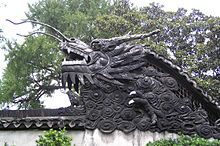
From the Han dynasty onward, the empire had developed a sophisticated art culture, in which art became an important element in the country's cultural life.
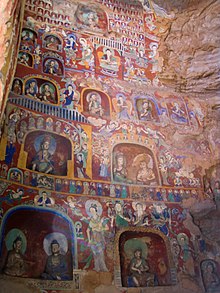
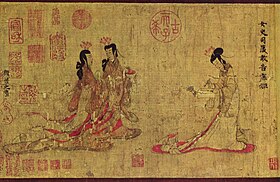
The Sui and Tang era saw Buddhist sculpture of the
The Ming and Qing era saw a new era of arts to prosper.
Sculpture, a major element in China's decorative arts, first developed under the Qin, but subsequently became more associated with Buddhism.[522] Native Chinese religions do not usually use cult images of deities, or even represent them, and large religious sculpture is nearly all Buddhist, dating mostly from the 4th to the 14th century, and initially using Greco-Buddhist models arriving via the Silk Road. Buddhism is also the context of all large portrait sculpture; in total contrast to some other areas in medieval China even painted images of the emperor were regarded as private. Imperial tombs have spectacular avenues of approach lined with real and mythological animals on a scale matching Egypt, and smaller versions decorate temples and palaces.[523] Small Buddhist figures and groups were produced to a very high quality in a range of media,[524] as was relief decoration of all sorts of objects, especially in metalwork and jade.[525] Sculptors of all sorts were regarded as artisans and very few names are recorded.[526]
Architecture
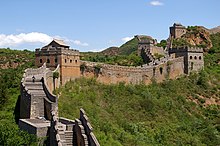
Chinese architecture refers to a style of architecture that has taken shape in East Asia over many centuries. Especially Japan, Korea, Vietnam and Ryukyu. The structural principles of Chinese architecture have remained largely unchanged, the main changes being only the decorative details. Since the Tang dynasty, Chinese architecture has had a major influence on the architectural styles of Korea, Vietnam, and Japan.[527][528][529][530]
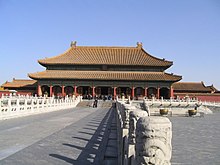
Chinese architecture is characterized by bilateral symmetry, use of enclosed open spaces,
Although unifying aspects exist, Chinese architecture varies widely based on status or affiliation, such as whether the structures were constructed for emperors, commoners, or for religious purposes. Other variations in Chinese architecture are shown in vernacular styles associated with different geographic regions and different ethnic heritages.[531]
Performance art
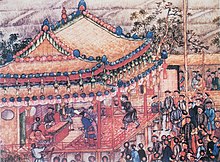
China had a rich history in performance art, in which their contribution have been signficant.
Opera
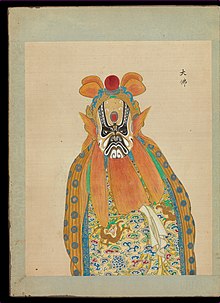
Chinese opera was introduced during the first interregnum era. An early form of Chinese drama is the Canjun Opera (參軍戲, or Adjutant Play) which originated from the Later Zhao Dynasty (319–351).[532][533][534] The opera was further developed under the Sui and Tang. For example, by the end of the Tang Dynasty the Canjun Opera had evolved into a performance with more complex plot and dramatic twists, and it involved at least four performers.[535] The early form of Chinese theatre became more organized in the Tang dynasty with Emperor Xuanzong (712–755), who founded the "Pear Garden" (梨园/梨園; líyuán), the first academy of music to train musicians, dancers and actors.[536] The performers formed what may be considered the first known opera troupe in China, and they performed mostly for the emperors' personal pleasure. To this day operatic professionals are still referred to as "Disciples of the Pear Garden" (梨园弟子 / 梨園弟子, líyuán dìzi).[537] By the Song Dynasty, Canjun Opera had become a performance that involved singing and dancing, and led to the development of Zaju (雜劇).[538] It reached a new development peak under the Ming and was retained greatly under the Qing with new version called Kunqu.[539][540][541] Some of the empire's most renowned operas were Tale of the Pipa and The Peony Pavilion.
The most popular of all opera renowned during the Chinese Empire was the Peking opera, a form of Hui opera. Introduced during the Qing era, it was the most dominant form of Chinese opera, which combines music, vocal performance, mime, martial arts, dance and acrobatics. It arose in Beijing in the mid-Qing dynasty (1644–1912) and became fully developed and recognized by the mid-19th century.[542] The form was extremely popular in the Qing court and has come to be regarded as one of the cultural treasures of China.[543]
Dance
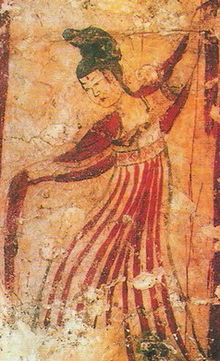
From the Qin dynasty onward established various departments responsible for the collection of music and dances, training of performers as well as their performances at the court, such as the
Some other forms of dance renowned from the empire included the dragon dance and lion dance. Dragon dances mentioned include a dance performed during a ritual to appeal for rain at a time of drought as the Chinese dragon was associated with rain,[550][551] acts in the baixi variety shows where performers dressed up as a green dragon playing a flute, and acts where fish turned into a dragon.[552][553] Modern dragon dance uses a light-weight structure manipulated by a dozen or so men using poles at regular intervals along the length of the dragon, and some forms of the dragon can be very long and involve hundreds of performers.
The lion dance has been suggested to have been introduced from outside China as the lion is not native to China.[554] Suggested origins of the dance include India and Persia, although some have also proposed a native Chinese origin.[555][556][557] A detailed description of a lion dance appeared during the Tang dynasty and it was then recognized as a foreign import, but the dance may have existed in China as early as the third century AD.[558] A version of lion dance was described by Tang poet Bai Juyi in his poem "Western Liang Arts" (西凉伎), where the dancers wear a lion costume made of a wooden head, a silk tail and furry body, with eyes gilded with gold and teeth plated with silver, and ears that move.[559] There are two main forms of Chinese Lion Dance: the Northern Lion and Southern Lion.
Media
While there had been various forms of media in the ancient time of the empire, mainly via edicts, newspapers and tablets (notably Kaiyuan Za Bao), the control and censorship had been long practised by every Emperor in the empire, prevented media from really developing due to its scattered nature.[560]
Organised media was only developed following the Qing dynasty's defeat in the Opium Wars, the foreign powers forced China to open treaty ports for foreign settlement.[561]: 32 The earliest newspapers in China developed in the treaty ports.[561]: 32 By the time of the First Sino-Japanese War, most of China's newspapers were owned by foreign missionaries and foreign merchants in the treaty ports.[561]: 32 Foreign-owned newspapers and principles of extraterritoriality imposed by the foreign powers in the treaty port decreased the Qing dynasty's ability to censor and control the flow of information.[561]: 32 Through foreign ownership, underlying mercantile interests, and the profit motive, newspapers in the late Qing era had significant limitations and bias in their reporting.[561]: 32 One notable modern form of bulletin under the empire was Peking Gazette.
Sports
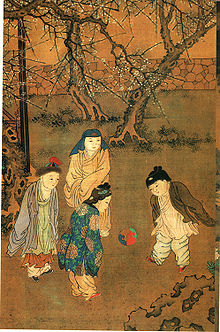
Traditional Chinese culture regards physical fitness as an important characteristic and thus sport had been practised, albeit in a varieties of form. It had originally been associated with
Cuisine
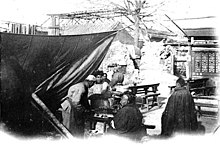
Cuisine of the Chinese Empire, one of the most diverse cuisine in the world, had been greatly influenced by the Huaxia cuisine and was greatly expanded as the empire's peripheral territories evolutionised.
The list in the
During the Tang, the many common foodstuffs and cooking ingredients in addition to those already listed were
The Yuan introduced a more unified blend of Chinese cuisine under their rule. Hu Sihui, a Mongol doctor of Chinese medicine, compiled the Yinshan Zhengyao, a guide to cooking and health which incorporated Chinese and Mongol food practices.[575][576] The recipes for the medicines are listed in a fashionable way which allow the readers to avoid lingering over the descriptions of the cooking methods. For instance, the description included the step by step instructions for every ingredients and follow by the cooking methods for these ingredients.[577] Yunnan cuisine is unique in China for its cheeses like Rubing and Rushan cheese made by the Bai people, and its yogurt, the yogurt may have been due to a combination of Mongolian influence during the Yuan dynasty, the Central Asian settlement in Yunnan, and the proximity and influence of India and Tibet on Yunnan.[578]
The Ming era saw rise of new forms of food thanked to the Columbian exchange. This included sweet potatoes, maize, and peanuts, foods that could be cultivated in lands where traditional Chinese staple crops—wheat, millet, and rice—couldn't grow, hence facilitating a rise in the population of China.[579][580] Many of them were retained under the Qing and thus contributed greatly to the new experience of Chinese cuisine.[581]
The records of the Imperial Banqueting Court (光禄寺; 光祿寺; Guānglù Sì; Kuang-lu ssu) published in the late Qing period showed there were several levels of Manchu banquets (满席; 滿席; Mǎn xí) and Chinese banquets (汉席; 漢席; Hàn xí).
Science and technology
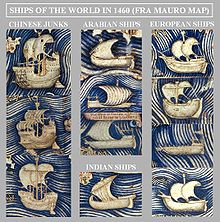
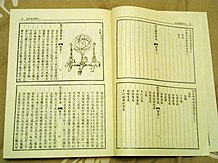
Throughout its long history, the Chinese Empire was the birthplace of many renowned innovations and inventions. The most famous of all of the innovation was the Four Great Inventions.[583] They are the compass,[584] gunpowder,[585] papermaking[586] and printing.[587] This allowed the empire to hold the world's leading position in many fields in the study of nature from the 1st century BC to the 15th century AD, with the four great inventions having the greatest global significance.[588]
-
Early Xi'An hemp paper, dated to at least 87 BC
-
Diagram of a Ming dynasty mariner's compass
-
A 'flying-cloud thunderclap-eruptor' firing thunderclap bombs from the Huolongjing
Outside of these Four Great Inventions, the engineering accomplishments of early China also included
The Yuan introduced a series of innovation.
Su Song was better known for his work in
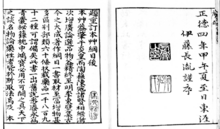
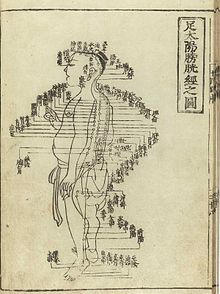
In Traditional Chinese medicine, the Yellow Emperor's Inner Canon (Huangdi Neijing), the oldest received work of Chinese medical theory, was compiled during the Han dynasty around the first century BCE on the basis of shorter texts from different medical lineages.[609] Emperor Gaozong (reigned 649–683) of the Tang dynasty (618–907) commissioned the scholarly compilation of a materia medica in 657 that documented 833 medicinal substances taken from stones, minerals, metals, plants, herbs, animals, vegetables, fruits, and cereal crops.[610] In his Bencao Tujing ('Illustrated Pharmacopoeia'), the scholar-official Su Song (1020–1101) not only systematically categorized herbs and minerals according to their pharmaceutical uses, but he also took an interest in zoology.[611][612][613][614] For example, Su made systematic descriptions of animal species and the environmental regions they could be found, such as the freshwater crab Eriocher sinensis found in the Huai River running through Anhui, in waterways near the capital city, as well as reservoirs and marshes of Hebei.[615]
Around 900–1000 AD, Chinese were the first to develop a form of vaccination, known as variolation or inoculation, to prevent smallpox. Chinese physicians had realised that when healthy people were exposed to smallpox scab tissue, they had a smaller chance of being infected by the disease later on. The common methods of inoculation at the time was through crushing smallpox scabs into powder and breathing it through the nose.[616]
Prominent medical scholars of the post-Han period included
By the 18th century, however, the Great Divergence occurred, which led to the major stagnation of Chinese scientific and technological development, with many reasons ranged from philosophical, economic, social and political reasons.[620][621][622] For whatever reasons, failure to develop further from their impressive feats of science and technology development were responsible for the eventual collapse of the Chinese Empire in 1912.
See also
- List of Chinese wars and battles
- Dynasties of China
- Timeline of Chinese history
- Chinese historiography
References
Notes
Citations
- ^ JSTOR 1170959.
- ^ JSTOR 2600793.
- ^ Turchin, Adams & Hall (2006), p. 222
- ^ The Rise of the Chinese Empire.
- ^ "Qin China".
- ^ "Qin Shi Huang | Biography, Accomplishments, Family, United China, Tomb, & Facts | Britannica". 8 April 2024.
- ISBN 978-0-521-89552-1.
- ^ https://www.ushistory.org/civ/9d.asp
- .
- ^ "Northeast Asian History Network".
- ^ "Sinification of East and Southeast Asia".
- ^ "Overview and expansion of the Qing dynasty - the Qing dynasty - KS3 History - homework help for year 7, 8 and 9".
- ^ "Qing dynasty (1644–1911)".
- ^ "The abdication decree of Emperor Puyi (1912)". 4 June 2013.
- ^ "The man who tried to become the Emperor of China". 3 February 2022.
- Qin XiaogongYilian Shiwu, reported the fault of sitting down, burned poems and written books to clarify the decree.
- ^ a b Li & Zheng (2001), p. 184.
- ^ Bodde (1987), p. 27.
- ^ "Two Would-Be Assassins Were Beat by a Stone Pillar and a Quick-Thinking Physician". 19 April 2023.
- ^ Li & Zheng (2001), p. 187.
- ^ Li & Zheng (2001), pp. 185–187.
- ^ Li & Zheng (2001), p. 188.
- ^ a b Beckwith (2009), 71
- ^ Li & Zheng (2001), pp. 214–217.
- ^ Eno, Robert (16 April 2024). "4.1 the Qin Dynasty".
- ^ Bi (2019).
- ^ (汉元年,沛公为汉王,王巴蜀,赐良金百溢,珠二斗,良具以献项伯。汉王亦因令良厚遗项伯,使请汉中地。项王许之。) Book of Han, vol.40
- ^ "Battle of Pengcheng: Xiang Yu vs. Liu Bang". March 2023.
- ^ "汉王刘邦为何北上打章邯?还有别的选择吗_巴蜀_项羽_南阳郡". Sohu.
- ^ Qian, Sima. Records of the Grand Historian, Sections: Emperor Gaozu of Han, Fan Kuai, Jin Xi, Li Shang.
- ^ ISBN 978-0-521-89552-1.
- ^ ISBN 978-0231153195.
- ISBN 978-0231101080.
- ^ Bielenstein (1986), pp. 227–230.
- ^ Hinsch (2002), pp. 23–24.
- ^ Bielenstein (1986), pp. 230–231.
- ^ Ebrey (1999), p. 66.
- ^ Yü (1986), p. 450.
- ^ de Crespigny (2007), pp. 562, 660.
- ^ Yü (1986), p. 454.
- ^ de Crespigny (2007), pp. 497, 500, 592.
- ^ Hinsch (2002), p. 25.
- ^ Hansen (2000), p. 136.
- ^ Beck (1986), pp. 349–351.
- ^ de Crespigny (2007), p. 36.
- ^ Beck (1986), pp. 353–357.
- ^ Hinsch (2002), p. 206.
- ^ "Chinese Emperors and Empresses: The Three Kingdoms and Emperor Wu of Jin".
- ^ "晋武帝为什么让司马衷继承皇位?司马衷是不是白痴-趣历史网".
- ^ "八王之乱为何爆发?西晋八王之乱爆发的原因_司马允_成都王_东海王". Sohu.
- ISBN 978-0-7607-1973-2.
- ISBN 978-0-7607-1976-3.
- ^ "安全验证 - 知乎".
- ISBN 978-0-300-07404-8.
- ISBN 9780674018280.
- ISBN 978-1-000-28314-3.
- ^ Liu, Puning (2018). "Song scholars' views on the Northern Wei legitimacy dispute". Archiv Orientální. 86: 112.
- ^ Felt, David Jonathan. “The Metageography of the Northern and Southern Dynasties.” T’oung Pao 103, no. 4–5 (2017): 334–87. https://www.jstor.org/stable/26566294.
- ISBN 9781000283143.
- ^ Ebrey, Walthall & Palais (2006), p. 89.
- ^ Ebrey, Walthall & Palais (2006), p. 90.
- ^ The Book of Sui, 《隋書 卷四帝紀第四 煬帝下》 "總一百一十三萬三千八百,號二百萬,其餽運者倍之。"
- ^ 《삼국사기》고구려본기 영양왕 三國史記 卷第二十 髙句麗本紀 第八
- ^ David A. Graff provides a modern estimate of 600,000.
- ISBN 978-0-203-20671-3.
- ^ Ebrey, Walthall & Palais (2006), pp. 90–91.
- ^ Adshead (2004), pp. 40–41.
- ^ a b "4.11: The Tang Dynasty and the Emergence of East Asia". 21 May 2019.
- ^ a b c d "The History Guy:Wars and Conflicts Between Tibet and China". www.historyguy.com.
- ^ "Compromise: The Silla-Tang Alliance".
- ISBN 9781134553532. Retrieved 3 November 2016.
- ^ Lee (1997), 16
- ^ a b Kim (2005), 40
- ISBN 9780674615762. Retrieved 6 November 2016.
- ISBN 9781610695824. Retrieved 6 November 2016.
- ^ Graff (2003), p. 200.
- ^ Graff (2002), p. 200.
- ^ a b Seth (2010), 44
- ^ a b Yu (2012), 31.
- ^ Lewis (2009), 154
- ^ Wechsler (1979), p. 223.
- ^ Golden, Introduction 135.
- ^ a b Wechsler (1979), p. 224.
- ^ a b Skaff (2009), p. 183.
- ^ Skaff (2009), p. 181.
- ^ Twitchett & Wechsler (1979), p. 280.
- ^ a b Skaff (2009), p. 184.
- ^ "Was Tibet Always Part of China?".
- ^ Chapter 196, Tubo. See wikisource
- ISBN 978-7-80057-035-3.
- ^ Zhou, Xiuqin (University of Pennsylvania) (April 2009). "Zhaoling: The Mausoleum of Emperor Tang Taizong" (PDF). Sino-Platonic Papers. 187: 155. Archived (PDF) from the original on 10 October 2022.
- ISBN 978-0-8160-6386-4
- ISBN 978-1-5381-2898-5.
- ^ Kim (2005), p. 41.
- ^ "舊唐書". 中國哲學書電子化計劃. Retrieved 3 August 2017.
上元三年二月,移安東府於遼東郡故城置。儀鳳二年,又移置於新城。In the second month of the third year of the Shangyuan era [676], the seat of Andong was moved to the Old City of Liaodong. In the second year of the Yifeng era [677], it was move again, this time to Xincheng.
- ^ Xiong (2008), p. 43.
- ^ Wang (2013), p. 84.
- ISBN 7-101-02890-X., pp. 235-236
- JSTOR 40379005.
- ^ Bai (2003), pp. 226–228.
- ^ Bai (2003), pp. 241–242.
- ISBN 978-7553816104.
- ^ Beckwith (2009)
- ^ Baumer (2012), p. 310.
- ^ 《殘唐五代史演義傳》:"卓吾子評:'僖宗以貌取人,失之巢賊,致令殺人八百萬,血流三千里'"
- ^ "Decline of the Tang Dynasty | World Civilization".
- ^ ISBN 9780191749537. Dudbridge actually quotes Reischauer's Ennin's Travels.
- ^ Kiernan (2019), p. 131.
- ^ Walker (2012), p. 212.
- ^ "Zhuang 08". mcel.pacificu.edu. Archived from the original on 8 February 2007. Retrieved 30 June 2022.
- ISBN 978-94-6239-390-5.
- ^ https://www.researchgate.net/publication/379303540_The_Empire_of_Western_Xia_and_the_Tangut_Economy
- ISBN 978-1107167865.
- ^ https://search.worldcat.org/title/social-history-of-middle-period-china-the-song-liao-western-xia-and-jin-dynasties/oclc/985755944?referer=di&ht=edition
- ^ Tillman (1995b), pp. [, page needed], .
- ^ China in 1000 CE: The Most Advanced Society in the World, in Ebrey, Patricia, & Conrad Schirokauer, consultants, The Song dynasty in China (960–1279): Life in the Song Seen through a 12th-century Scroll ([§] Asian Topics on Asia for Educators) (Asia for Educators, Columbia Univ.), as accessed October 6 & 9, 2012.
- ^ Beaudouin, Mathieu (2023). "Tangut and Horpa languages: some shared morphosyntactic features". Language and Linguistics. 24 (4).
- ISBN 978-0-521-24331-5.
- ^ "Goryeo: the dynasty that offered Korea its name". The Korea Times. 4 April 2012. Retrieved 21 May 2022.
- ^ Bielenstein (2005), p. 183-183.
- ^ Breuker 2010, pp. 220-221. "The Jurchen settlements in the Amnok River region had been tributaries of Koryŏ since the establishment of the dynasty, when T'aejo Wang Kŏn heavily relied on a large segment of Jurchen cavalry to defeat the armies of Later Paekche. The position and status of these Jurchen is hard to determine using the framework of the Koryŏ and Liao states as reference, since the Jurchen leaders generally took care to steer a middle course between Koryŏ and Liao, changing sides or absconding whenever that was deemed the best course. As mentioned above, Koryŏ and Liao competed quite fiercely to obtain the allegiance of the Jurchen settlers who in the absence of large armies effectively controlled much of the frontier area outside the Koryŏ and Liao fortifications. These Jurchen communities were expert in handling the tension between Liao and Koryŏ, playing out divide-and-rule policies backed up by threats of border violence. It seems that the relationship between the semi-nomadic Jurchen and their peninsular neighbours bore much resemblance to the relationship between Chinese states and their nomad neighbours, as described by Thomas Barfield."
- ^ http://tapchiqptd.vn/en/research-and-discussion/the-thought-of-strike-first-in-the-war-against-song-aggressors-1075-%E2%80%93-1077/8109.html
- ^ Anderson (2008), p. 209.
- ^ Kiernan (2019), p. 158-9.
- ^ "Mongols in World History | Asia for Educators".
- )
- ISBN 9781133606475.
- ISBN 1860649726.
- ^ Mote (1999), p. 256.
- ISBN 9780203403112.
- ^ Potts, Emily (January 2014). "The Weaknesses of Song China and the Legacy of Mongol Conquest". The Student Researcher: A Phi Alpha Theta Publication.
- ^ "列傳第二 后妃下 (Biographies 2, Imperial wives and concubines [lower volume])". 金史 [History of Jin] (in Chinese). Vol. 64.
- ^ Franke (1994), p. 264.
- ^ Mote (1999), p. 215.
- ^ C. P. Atwood Encyclopedia of Mongolia and the Mongols, p.613
- ISBN 978-9004282483.
- ^ "江门丨崖门海战--中国国家人文地理--人民网".
- ^ ISBN 978-4-8053-1659-7.
- ^ Rossabi (1988), p. 62.
- ^ Allsen (1994), p. 413.
- ^ a b Aung-Thwin and Hall 2011: 34–35
- ^ Lieberman 2003: 121
- ^ Wylie, ibid.p.323: 'it is suggested here that references in Chinese sources pertain to campaigns in peripheral areas and that there was no Mongol invasion of central Tibet at that time.'
- ^ "Saved by the Wind? The Mongol Invasions of Japan". 23 December 2021.
- ^ "The Mongol Empire and Divine Winds: The Mongol Invasion of Japan". 11 July 2021.
- ^ Nugroho (2011), p. 115, 118–119.
- ^ Groeneveldt (1876), p. 25 and 27.
- ^ Anderson (2014), p. 126.
- ^ Lo (2012), p. 294.
- ^ Taylor (2013), p. 139.
- ^ Baldanza (2016), p. 24.
- ^ "What Led to the Red Turban Rebellion?". 22 November 2020.
- ^ .
- ISBN 978-0-520-28974-1.
- ISBN 978-1-4985-7432-7.)
{{cite book}}: CS1 maint: multiple names: authors list (link - ISBN 978-1139054751.
- ISBN 978-90-04-10391-7.
- ^ Farmer (1995), p. 36
- ^ Zhang Wenxian. "The Yellow Register Archives of Imperial Ming China Archived 26 April 2019 at the Wayback Machine". Libraries & the Cultural Record, Vol. 43, No. 2 (2008), pp. 148–175. Univ. of Texas Press. Retrieved 9 October 2012.
- ^ "The Mongols during the Ming period (www.chinaknowledge.de)".
- ^ Dutton (2012), p. 31.
- ^ Chan 1998, 223.
- ^ a b USAFA (1998), p. 210.
- ^ ISBN 978-0-313-33733-8 p. 151 [1]
- ISBN 978-1-78527-101-4.
- ^ Kiernan (2009), p. 110.
- ^ Rost (1887), p. 251.
- ^ Wade, Geoff (2005), Southeast Asia in the Ming Shi-lu: an open access resource, Asia Research Institute and the Singapore E-Press, National University of Singapore, p. 2427, retrieved 6 November 2012
- ^ http://en.chinaculture.org/gb/en_aboutchina/2003-09/24/content_22829.htm
- ^ Swope (2002), p. 761.
- ^ Lewis (2014), p. 277 "Ming's participation, however, was motivated more by self-defense than by the intention to help Chosŏn. At the time, Japan had explicitly declared its plans to "borrow a road to enter the Ming." Because of this, Ming feared for the security of Liaodong, and eventually came to worry about the threat to Beijing from a Chosŏn occupied by the Japanese army.
- ^ Turnbull (2008), p. 20.
- ^ Turnbull (2008), p. 17.
- ^ Swope (2002), p. 781.
- ^ 陈璘后裔翁源祭祖宗 [Weng Yuan, a descendant of Chen Lin, pays homage to his ancestors] (in Simplified Chinese). Jinyang.com-Yangcheng Evening News. 8 December 2002. Archived from the original on 30 September 2007.
- ^ Spence (1999), p. 3.
- ^ Spence (1999), p. 25.
- ^ Spence (1999), p. 32.
- ISBN 978-1-139-05475-1.
- ^ "How the Dutch Lost Taiwan".
- ^ Swope (2014), p. 65.
- ^ Swope (2014), p. 101.
- ^ Swope (2014), p. 114.
- ^ Kang (2013), p. 154-155.
- ^ Swope (2014).
- ^ Fang (1943a), p. 255
- ^ https://www.researchgate.net/publication/321516828_China's_Conquest_of_Taiwan_in_the_Seventeenth_Century_Victory_at_Full_Moon
- ISBN 978-986-7151-64-3. (Although this particular book seems to misspell 海色 as 海包 (Haibao) or Izenei (Изеней or Исиней))
- ^ Август 1652 г. Из отписки приказного человека Е.П. Хабарова якутскому воеводе Д.А. Францбекову о походе по р. Амуру. Archived 2011-10-04 at the Wayback Machine An excerpt from Khabarov's report to the Yakutsk Voivode D.A.Frantsbekov, August 1652.) (in Russian)
- ^ Rowe (2009), p. 63.
- ^ a b 孔令偉. "西藏為何重要?──從清朝對西藏、喜馬拉雅與印度的情報蒐集談起" (in Chinese (Taiwan)). 中研院歷史語言研究所.
- ^ China Marches West: The Qing Conquest of Central Eurasia, by Peter C Perdue, p623
- ^ a b Allworth, Edward (16 December 1991). "History > Kazakhstan to c. AD 1700". Encyclopædia Britannica. Archived from the original on 24 October 2007. Retrieved 19 February 2013.
- ^ Millward, James A. Eurasian Crossroads: A History of Xinjiang.[page needed]
- ^ Mosca, Matthew. From Frontier Policy to Foreign Policy: The Question of India and the Transformation of Geopolitics in Qing China.[page needed]
- ^ a b "History of the Nepalese Army". nepalarmy.mil.np. Archived from the original on 7 June 2011. Retrieved 1 August 2022.
- ^ Regmi (1970a), p. 187.
- ^ Gundry, "Nepal," pp. 609-610., p. 609, at Google Books
- JSTOR 3876499.
- ^ Giersch (2006), p. 101.
- .
- ISBN 9780674727991.
- ISBN 978-981-287-958-5.
- ^ Sarkees & Wayman, Resort to War (2010), p. 504.
- ^ Fisher, Rose & Huttenback, Himalayan Battleground (1963), pp. 49–59.
- ^ a b c "How Did the Opium Wars Impact China?". 5 November 2023.
- ^ Porter, Maj Gen Whitworth (1889). History of the Corps of Royal Engineers Vol I. Chatham: The Institution of Royal Engineers.
- ^ Canada, Asia Pacific Foundation of. "The Opium Wars in China". Asia Pacific Curriculum. Retrieved 28 November 2021.
- ^ https://carnegiemoscow.org/commentary/60357
- ^ https://asiasociety.org/switzerland/events/talk-library-british-exploration-19th-century-tibet
- ^ "Alexander Morrison - the Russian Conquest of Central Asia a Study in Imperial Expansion, 1814-1914 (Cambridge University Press, 2020)".
- ^ Platt (2012), p. p. xxiii.
- ^ "Global Trends: Facing up to a Changing World".
- ISBN 978-1-317-26628-0.
- ^ Jian Youwen (1973), p. 8.
- ^ Franz Michael, "Military Organization and Power Structure of China During the Taiping Rebellion," Pacific Historical Review 18.4 (1949): 469–483. http://www.jstor.org/stable/3635664
- ^ David Strand, and Ming K. Chan, "Militarism and Militarization in Modern Chinese History". Trends in History 2.2 (1981): 53–69.
- ^ "咸同贵州各族人民大起义". news.sina.com.cn. Retrieved 30 August 2021.
- ISSN 1934-7227.
- ISBN 90-04-07164-4. Retrieved 26 March 2011.
- ^ Atwill (2005)
- ^ "招商局历史博物馆".
- ^ Asian Profile. Asian Research Service. 2003.
- ISBN 978-90-04-42488-3.
- ISBN 1563242427.
- ^ a b Boulger (1878), p. 274.
- ^ a b Boulger (1878), p. 298.
- ^ https://www.chikyu.ac.jp/ilipro/page/18-publication/workshop-book/workshop-book_individual%20files/3-4_Noda.pdf
- ISBN 978-0-521-22029-3.
- ISBN 978-0-7914-7742-7.
- ISBN 978-1-134-25379-1.
- ^ Elleman (2001), p. 85.
- ^ Elleman (2001), p. 87.
- ^ Le Journal des débats, 31 March 1885; Reclus, 334–49; Thomazi, 262
- ^ ISBN 978-0-521-66899-6.
Japan was at the forefront of hegemonic wars in a quest to extend the Japanese hegemony over Korea to the entire Asia-Pacific region – the Sino–Japanese War of 1894–95 to gain dominance in Korea.
- ^ a b Paine (2003), p. 3.
- ^ "Introduction | the Sino-Japanese War of 1894-1895 : as seen in prints and archives".
- ^ https://agc.ac.in/resources/boxer_rebellion_pdf.pdf
- ^ Nordholt, J. W. Schulte; van Arkel, D., eds. (1970). Acta Historiae Neerlandica: Historical Studies in the Netherlands. Vol. IV. Brill Publishers. pp. 160–161, 163–164.
- ^ a b "History of Modern East Asia". National Taiwan University. Retrieved 28 March 2021.
- ^ S2CID 228815919.
- ^ Bray, John (2011). "Sacred Words and Earthly Powers: Christian Missionary Engagement with Tibet". The Transactions of the Asiatic Society of Japan. fifth series (3). Tokyo: John Bray & The Asian Society of Japan: 93–118. Archived from the original on 1 July 2014. Retrieved 13 July 2014.
- ISBN 0231134460. Archivedfrom the original on 19 March 2015. Retrieved 24 April 2014.
- ISBN 9787802112940.
- ISBN 978-0-8153-0720-4. p. 106. p. 344.
- ISBN 978-1-62273-508-2 – via Google Books.
- ^ )
- ^ 王丽娜 (2008). 光绪朝江皖丙午赈案研究. School of History, Renmin University (PhD thesis).
- ^ 樊超杰 (2014). 光绪三十二年苏北水灾赈济研究. 山东师范大学 (Master thesis).
- San Francisco Call, Volume 101, Number 128, 7 April 1907, p.39.
- ^ Curti, Merle (1963). American Philanthropy Abroad: A history. p. 216.
- ^ "中國窗-香港商報電子報". Cnwnc.com. Retrieved 12 October 2011.[dead link]
- ISBN 962-8885-28-6. pp. 195–198.
- ISBN 978-0-615-24479-2.
- ISBN 9780742578159.
- ISBN 9789629373214.
- ISBN 9789629372910.
- S2CID 143605067.
- ^ https://www.amazon.com/Atlas-Chinese-Empire-Edward-Stanford/dp/1015905811
- ^ "Has China always been ruled by a Han elite?". 11 November 2022.
- ^ https://www.amazon.com/Yangtze-River-Yellow-Chinese/dp/7546135249
- ^ "How comparable was Chinese westward expansion to the same phenomenon in the United States and Russia? Did the Chinese ever romanticize their western frontier in the same way the Americans romanticized theirs?". 2 September 2023.
- JSTOR 2172247.
- ^ a b c d e f "What Can 4,000-Year-Old Censuses Tell Us About Ancient China?".
- ^ a b c d "Asia for Educators | Columbia University".
- ^ "Qin Dynasty | China & Asia Cultural Travel". 4 March 2016.
- .
- ^ "Yuan Dynasty".
- ^ "The Manchu language".
- ^ "Living in the Chinese Cosmos: Understanding Religion in Late-Imperial China". afe.easia.columbia.edu.
- ^ "Living in the Chinese Cosmos | Asia for Educators".
- ^ "Confucianism".
- JSTOR j.ctt7zth0m.
- ^ Hackett, Conrad; Grim, Brian J. (18 December 2012). "Other Religions". Pew Research Center. The Global Religious Landscape. Archived from the original on 1 September 2023. Retrieved 20 May 2023.
- ISBN 978-0-393-91847-2. Archivedfrom the original on 1 September 2023. Retrieved 21 May 2019.
- ^ Creel (1982), p. 2.
- ^ https://study.com/academy/lesson/the-spread-of-buddhism-in-tang-china.html
- ^ "Buddhism".
- ^ "3. Buddhism". 30 August 2023.
- ^ Jiang Wu, "The Chinese Buddhist Canon" in The Wiley Blackwell Companion to East and Inner Asian Buddhism, p. 299, Wiley-Blackwell (2014).
- Wei Shu(《魏书·释老志》):“世祖初继位,亦遵太祖、太宗之业,每引高德沙门,与共谈论。……及得寇谦之道,帝以清净无为,有仙化之证,遂信行其术。时司徒崔浩,博学多闻,帝每访以大事。浩奉谦之道,尤不信佛,与帝言,数加非毁,常谓虚诞,为世费害,帝以其辩博,颇信之。”
- ^ Wei Yüan-sung
- ^ a b c Chinese records state Zoroastrianism and Christianity were regarded as heretical forms of Buddhism during this time. (see Chapter 5: Christianity in China)
- ^ Ch'en, Kenneth (1956). The Economic Background of The Hui-ch'ang Suppression of Buddhism, Harvard Journal of Asiatic Studies, 19, (1/2), 67-105 – via JSTOR (subscription required)
- ^ four imperial persecutions of Buddhism in China
- ^ s:zh:資治通鑑:第292卷.
- ^ New History of the Five Dynasties, vol. 12 [2]. Archived October 11, 2007, at the Wayback Machine
- ^ Old History of the Five Dynasties, vol. 5 [3]. Archived February 18, 2006, at the Wayback Machine
- ISBN 978-0-941532-89-1
- ^ Keown, Damien. A Dictionary of Buddhism. 2003. p. 104
- ^ Chün-fang Yü. Chinese Buddhism: A Thematic History, University of Hawaii Press, pp. 240. 2020.
- ^ a b Mullin 2001, p. 358
- ^ Nan Huai-Chin. Basic Buddhism: Exploring Buddhism and Zen. York Beach: Samuel Weiser. 1997. p. 99.
- ^ "The Khubilghan: The Incarnated Lamas of the Qing Dynasty and Related Artifacts". 28 November 2020.
- ^ Wang, Lianmao (2000). Return to the City of Light: Quanzhou, an eastern city shining with the splendour of medieval culture. Fujian People's Publishing House. Page 99.
- ^ Lipman (1997), p. 29.
- ISBN 978-1576075166. Retrieved 24 April 2014.
- ^ Lipman (1997), pp. 24.
- ^ "How Did the Turks Become Muslim in Year 751, till 2020 the Republic of Turkey Today".
- ^ Israeli (2002), pp. 283–284.
- ^ Hagras, Hamada (2019). "Xi'an Daxuexi Alley Mosque: Historical and Architectural Study". Egyptian Journal of Archaeological and Restoration Studies "EJARS". 1: 97–113. Archived from the original on 13 December 2019. Retrieved 5 July 2019.
- ISBN 9789814459723. Retrieved 24 March 2022.
- ^ C. P. Atwood Encyclopedia of Mongolia and the Mongol Empire, p.354
- ISBN 0-618-42770-8
- ISBN 978-0-674-59495-1. Retrieved 28 June 2010.
- ^ doi:10.36816/shedet.006.08. Archived from the originalon 18 October 2020. Retrieved 15 March 2020.
- ^ China archaeology and art digest, Volume 3, Issue 4. Art Text (HK) Ltd. 2000. p. 29.
- ISBN 978-0-674-59497-5.
- ISBN 978-0-333-53174-7.
- ISBN 978-0804729338. Retrieved 24 April 2014.
- ISBN 978-1317938521. Retrieved 24 April 2014.
- ISBN 0-393-30780-8. - access date: 2010-06-28
- ISBN 978-1136576096.
- ^ Mackintosh-Smith (2014), p. 69.
- ISBN 1-56324-730-5.
- ISBN 0-521-49712-4.
- ISBN 978-0-7007-1026-3. Retrieved 28 June 2010.
- ISBN 978-0674042025.
- ^ Levi (2017), pp. 37–38.
- ISBN 0804797927.
- ISBN 9004145508.
- ^ Wang, Ke (2017). "Between the "Ummah" and "China":The Qing Dynasty's Rule over Xinjiang Uyghur Society" (PDF). Journal of Intercultural Studies. 48. Kobe University: 204. Archived from the original (PDF) on 1 June 2019. Retrieved 1 June 2019.
- ISBN 90-04-07164-4. Retrieved 26 March 2011.
- ^ Myint-U (2007), p. 172.
- ^ Moule, Christians in China before the Year 1550, 38
- ^ Moffett, pp. 14–15.
- ^ Li, Dun J. (1965). The Ageless Chinese: A History. New York: Charles Scribner's Sons. p. 373.
- S2CID 164239427.
- ISBN 978-3-643-90329-7.)
{{cite book}}: CS1 maint: multiple names: authors list (link - ISSN 1754-517X.
- ISBN 978-1-78672-316-1.
- .
- ISBN 978-1-351-67277-1.
- ^ Philip, p. 123.
- ^ Wilmshurst, The Martyred Church, 222
- S2CID 164412254.
- ISBN 978-1-60833-162-8.
- S2CID 225038696.
- ^ "Florence Hodous | Semantic Scholar".
- ^ "Florence Hodous | Independent Scholar - Academia.edu".
- ISBN 978-3-447-06580-1.
- ^ Moule, Christians in China before the Year 1550, 216–40
- ISBN 978-3-447-06580-1.
- ISSN 2077-1444.
- ^ "When Christianity was tolerated in early Qing China". 24 March 2021.
- ^ Kuiper (2006).
- ^ Robert Samuel Maclay (1861). Life among the Chinese: with characteristic sketches and incidents of missionary operations and prospects in China. Carlton & Porter. p. 336. Retrieved 6 July 2011.
mohammedan slaves to beys.
- ^ Robert Samuel Maclay (1861). Life among the Chinese: with characteristic sketches and incidents of missionary operations and prospects in China. New York: Carlton & Porter. p. 337. Retrieved 6 July 2011.
foreigners strangled or expelled.
(Original from the New York Public Library) - ^ Joseph Esherick, The Origins of the Boxer Uprising (1987), pp. 190–191; Paul Cohen, History in Three Keys (1997), p. 51.
- ^ East India (Tibet): Further Papers relating to Tibet [In continuation of Cd 2370]. H. M. Stationery Office. 1904. p. 17. Retrieved 28 June 2011.
- ^ Wee, Vivienne (1976). "'Buddhism' in Singapore". In Hassan, Riaz (ed.). In Singapore: Society in Transition. Kuala Lumpur: Oxford University Press. pp. 155–188.
- ^ "Zoroastrianism (Zorodian)". chiculture.net. Archived from the original on 22 December 2018. Retrieved 22 December 2018.
- ^ Zhao Hongjuan (10 October 2018). "Explore the integration of Zoroastrian customs and Chinese festival customs from the Dunhuang "Sai Zuo" in the Late Tang and Five Dynasties". cssn.cn. Archived from the original on 17 August 2020. Retrieved 23 December 2018.
- ^ Lin Wushu (2005). "The Social Trend of Sanyi Religion in the Five Tang Dynasty". "Middle Ancient Sanyi Religion Dialectics". Beijing: Zhonghua Book Company.
- ^ Lin Wushu. "Mingjiao: Manichaeism rooted in China" (PDF). zsdh.library.sh.cn. Archived from the original (PDF) on 30 December 2018. Retrieved 29 December 2018.
- ISBN 1-4179-1234-0
- ISBN 965-229-347-4.
- ^ "The Ancient Religion of Tengriism".
- ^ "Tengrism is the religion of steppes and nature".
- ^ "Korean Shamanism, the Origins of Indigenous Culture – Asian Traditional Theatre & Dance".
- ^ )
- ^ "Rise of Chinese dynasties (Article)".
- ^ Nadeau, Randall L. The Wiley-Blackwell Companion to Chinese Religions, pp. 54 ff. John Wiley & Sons (Chichester), 2012. Accessed 22 December 2013.
- ISBN 978-0-89236-987-4.
- S2CID 143236087.)
{{cite journal}}: CS1 maint: multiple names: authors list (link - ^ Ch'ü (1972), 68–69.
- ISSN 0038-4038.
- OCLC 51978070.
- )
- ^ OCLC 70863722.
- )
- S2CID 219695026.
- JSTOR 2718206.
- ISBN 978-0-547-00534-8. Retrieved 11 January 2011.
- ISBN 978-1-61530-181-2. Retrieved 11 January 2011.
- ISBN 978-0-8160-4640-9. Retrieved 11 January 2011.
- ISBN 978-0-87220-818-6. Retrieved 11 January 2011.
- ISBN 978-1-59460-039-5. Retrieved 11 January 2011.
- ^ Gernet (1996), 244.
- Jianfu Chen (1960) p.9., Chinese Law: Context and Transformation: Revised and Expanded Edition, https://books.google.com/books?id=Q2xyDAAAQBAJ&pg=PA9
- ^ a b Gernet (1996),ball 244-245.
- ^ "Kaihuang Code (开皇律)" (in Chinese). Archived from the original on 7 July 2011. Retrieved 8 September 2010.
- ^ Chen, Ivan (1908). "Chapter XI". The Book of Filial Duty.
- ^ Emperor Yang of the Sui Dynasty: His Life, Times, And Legacy - S. 136 Online
- .
- ^ "dianmai" (in Chinese). Zdic.net. Retrieved 8 June 2012.
- .
- ^ Reynolds (1993).
- .
- ^ a b "Military".
- ^ "Archers in Ancient Chinese Warfare".
- ^ Peers (1995), p. 15.
- ^ Whiting (2002), p. 131.
- ^ Chang (2007), p. 174-175.
- ^ Chang (2007), p. 178.
- ^ Lorge (2011), p. 68.
- ^ Needham (1994), p. 141.
- ^ Peers (2006), p. 75.
- ^ Peers (2006), p. 83.
- ^ Graff (2002), p. 193.
- ^ Liang (2006).
- ^ Graff (2002), p. 190.
- ^ Graff (2002), p. 191.
- ^ a b Peers (2006), p. 111.
- ^ Peers (2006), p. 114.
- ^ Graff (2016), p. 51.
- ^ Graff (2002), p. 176.
- ^ Lorge (2011), p. 103.
- ^ Fu (2018), p. 125.
- ISBN 0521842263.
- ^ Peers (2006), p. 132.
- ^ Whiting (2002), p. 305.
- ^ Peers, 130.
- ^ Ebrey et al., East Asia, 164.
- ^ Needham, Volume 5, Part 7, 263-364.
- ^ a b Lu (1988).
- ISBN 978-0-521-24331-5.
- ISBN 978-0-521-24331-5.
- ISBN 9780804711937. Retrieved 27 May 2016.
- ISBN 9781610693400.
- ISBN 9780674012127.
- ^ Patrick (1961), p. 6.
- ISBN 978-0-521-24332-2.
- ISBN 978-962-209-501-4.
- ISBN 90-04-10391-0.
- ISBN 978-0-8047-5174-2.
- ^ "Ming Empire 1368-1644".
- ^ Selby, Stephen. "ATARN Chinese Traditional Archery Training". Chinese Archery - An Unbroken Tradition?. Archived from the original on 12 October 2015. Retrieved 17 December 2010.
- ^ Sim (2017), p. 234.
- ^ 丁国瑞 (2017). "明代军事志的发展特点和价值研究》". 中国地方志 [China Local Records] (in Chinese). 3.
- ^ 彭勇; 崔继来 (2017). "《四镇三关志》概说". 《晋阳学刊》. 6: 29–34.
- ^ Andrade (2016), p. 201.
- ^ Elliott (2001), p. 40.
- ^ Millward 2007, p. 95.
- . Retrieved 3 December 2023.
By the middle of the eighteenth century, the total number of Qing military forces may have reached 800,000 (200,000 bannermen, and 600,000 Green Standard troops); Ergang, Luo 羅爾綱, Lüying bingzhi 綠營兵制 (Beijing: Zhonghua shuju, 1984), 7–9 Google Scholar.
- ^ Schottenhammer (2015), p. 454-456.
- ^ Schottenhammer (2015), p. 456-457.
- ISBN 978-1-78204-910-4.
- ^ Sim (2017), p. 236.
- ISBN 978-9971-69-505-7.
- ^ "Battle of Tunmen: The first clash between China and Europe". 10 May 2023.
- ^ 金羊网 (8 December 2002). "陳璘後裔翁源祭祖宗". Archived from the original on 30 September 2007.
- ^ Cooper (1979), p. 658.
- ^ Freeman (2003), p. 132.
- ^ Thomson (1996), p. 39.
- ^ 賴, 永祥 (1965). "台灣鄭氏與英國的通商關係史". 台灣文獻. 第16卷第2期.
- ^ "China's 'southern disaster': France lays waste to a Qing fleet". 23 August 2023.
- ISBN 9780821362082.
- ^ a b c Dahlman, Carl J; Aubert, Jean-Eric. China and the Knowledge Economy: Seizing the 21st Century. WBI Development Studies. World Bank publications. Accessed January 30, 2008.
- ^ Angus Maddison. Chinese Economic Performance in the Long Run Archived 2014-10-15 at the Wayback Machine. Development Centre Studies. Accessed 2007. p.29 See the "Table 1.3. Levels of Chinese and European GDP Per Capita, 1–1700 AD" in page 29, Chinese GDP Per Capita was 450 and European GDP Per Capital was 422 in 960AD. Chinese GDP Per Capita was 600 while European was 576. During this time, Chinese per capita income rose by about a third.
- ^ Bodde (1987), p. 61
- ^ Zhan (2006)
- ^ Li & Zheng (2001), pp. 235–308
- ^ Li & Zheng (2001), p. 243
- ^ Loewe (1986), p. 150
- ^ Ji et al. (2005a), pp. 73–75
- ^ Nishijima, Sadao. (1986). 22.
- ^ Nishijima (1986), pp. 587–88
- ^ Ebrey (1999), p. 62
- ^ Ji et al. (2005a), p. 111
- ^ a b c Li & Zheng (2001), p. 548
- ^ Li & Zheng (2001), pp. 585–87
- ^ Ji et al. (2005b), p. 17
- ^ Xie (2005)
- ^ Ji et al. (2005b), p. 34
- ^ Schafer (1985), p. 9
- ^ "Economy of the Liao Empire (www.chinaknowledge.de)".
- ISBN 978-94-6252-230-5.
- ^ Rossabi (1988), p. 76
- ^ Ebrey, Walthall & Palais (2006), p. 157
- ^ Hobson (2004), p. 77
- ^ Rossabi (1995), pp. 454–55
- ISSN 0013-0117.
- ^ Rossabi (1995), pp. 473–75
- ^ Mote (1988), p. 4
- ^ Li & Zheng (2001), p. 950
- ^ Mote (1988), p. 3
- ^ Li & Zheng (2001), p. 996
- ^ Li & Zheng (2001), pp. 994–95
- ^ Myers & Wang (2002), p. 564
- ISBN 978-2-02-133804-1.
- ^ Shi (2006), p. 9.
- ^ Shi (2006), p. 10.
- ISBN 978-0-393-04017-3.
- ISBN 9780691090108.
- ^ a b https://academic.oup.com/book/9822/chapter-abstract/157059360?redirectedFrom=fulltext&login=false
- ^ "A Chinese School". Wesleyan Juvenile Offering. IV: 108. October 1847. Retrieved 17 November 2015.
- ^ a b c "Ancient Chinese Education".
- ISBN 978-981-287-532-7, retrieved 29 November 2021
- ^ Hsu, Immanuel (July–September 1964). "The Reorganisation of Higher Education in Communist China, 1949–61" (19). The China Quarterly: 128–160.
{{cite journal}}: Cite journal requires|journal=(help) - ^ ISBN 978-1-5017-7415-7.
- ISBN 978-1-7368500-8-4.
- ^ 書 being here used as in 楷书/楷書, etc, and meaning "writing style".
- ^ Hsia (1968), p. 1–2, 6.
- ^ Kim, Hyung-eun (11 July 2008). "(Review) Historical China film lives up to expectations". Korea JoongAng Daily. Archived from the original on 25 December 2011.
The Romance of the Three Kingdoms is comparable to the Bible in East Asia. It's one of the most-read if not, the most-read classics in the region.
{{cite web}}: CS1 maint: unfit URL (link) - ^ Herbert Giles (1901). A History of Chinese Literature. London: W. Heinemann. p. 277.
If a vote were taken among the people of China as to the greatest among their countless novels, the Story of the Three Kingdoms would indubitably come out first.
- ^ Cai 2008, p. 59 et seq., Chapter 3
- ^ The New Book of Tang 文宗時,詔以白歌詩、裴旻劍舞、張旭草書為「三絕」
- ^ Ebrey, 103.
- ^ Cai 2008, p. 329 et seq., Chapter 16
- ^ Chaves 1986, pp. 8–9
- ^ Cai 2008, p. 354 et seq., Chapter 17; Cai 2008, p. 376 fn. 2 notes effort to compile complete collection of Ming poetry began in 1990
- JSTOR 189319.
- ISBN 978-0-231-54114-5.
- ^ Patricia Ebrey (1999), Cambridge Illustrated History of China, Cambridge: Cambridge University Press, p. 148.
- ^ ISBN 978-8176487986
- ^ Journal of Music in China, Volume 4, p.4
- ISBN 978-9380601175
- ^ History of Civilizations of Central Asia edited by Unesco
- ^ a b van Aalst, J.A. (1884) [1884]. Chinese Music. Shanghai: Statistical Department of the Inspectorate General of Customs.
- ISBN 0-8223-2694-9.
- ISBN 978-9629963606.
- ^ "Collections|The Palace Museum". en.dpm.org.cn. Archived from the original on 4 October 2022. Retrieved 4 October 2022.
- ^ Museum, National Palace (25 June 2021). "Collection". National Palace Museum. Retrieved 4 October 2022.
- ISBN 0-500-05090-2.
- ISBN 978-1-904832-77-5.
- ^ Bradsher, Keith (3 July 2007). "'China's Mona Lisa' Makes a Rare Appearance in Hong Kong". The New York Times. China;Hong Kong;Great Britain. Retrieved 13 November 2011.
- ISBN 978-94-6252-471-2.
- ^ Capon and Pang, pg. 42
- ^ Capon and Pang, pg. 120
- ^ Capon and Pang, pg. 90, 91
- ^ Rawson, 138-138
- ^ Rawson, 135–145; 145–163
- ^ Rawson, 163–165
- ^ Rawson, Chapters 4 and 6
- ^ Rawson, 135
- ISBN 978-1406769760.
- ISBN 9780764118166. Archivedfrom the original on 20 March 2018. Retrieved 19 March 2018 – via Google Books.
- ISBN 9781134575428. Archivedfrom the original on 20 March 2018. Retrieved 19 March 2018 – via Google Books.
- ISBN 9780191542411. Retrieved 19 March 2018 – via Google Books.
- ^ a b Liang Sicheng, year 12, A pictorial history of Chinese architecture : a study of the development of its structural system and the evolution of its types, ed. by Wilma Fairbank, Cambridge (Mass.): MIT Press.
- ISBN 978-0810855144.
- ^ "唐代參軍戲". 中國文化研究院.
- ^ "Sichuan Opera". Archived from the original on 24 February 2007.
- ISBN 978-0521186667.
- ISBN 978-0810855144.
- ^ "Chinese Opera". onlinechinatours.com. Retrieved 12 July 2011.
- ^ Rossabi, 162.
- ISBN 978-0472089239.
- ISBN 978-0521186667.
- ^ "川 剧styles". 中国剧种大观 CCNT. Archived from the original on 30 April 2001.
- ^ Goldstein 2007, page 3.
- ^ Mackerras 1976, pages 473–501.
- ISBN 978-0700704392.
- ISBN 978-9629371401.
- ISBN 978-0835111867.
- ISBN 9004039171.
- ISBN 978-9004105966.
- ISBN 978-9057020261.
- ISBN 978-0195332636.
- ^ "《求雨》". Chinese Text Project.
- ISBN 978-0313361180.
- ^ "西京賦".
- ISBN 978-0521278379.
- ISBN 978-3515026512.
- ISBN 9004125965,
During the Persian New Year of Newruz, a lion dance used to be performed by young boys, some of the naked it seems, who were sprinkled with cold water. They were thus supposed to drive out evil forces and the cold of the winter.
- ISSN 1226-4490. Archived from the original(PDF) on 20 December 2016. Retrieved 24 August 2019.
- ISBN 9789004072916.
- ^ "《西凉伎》". Archived from the original on 19 February 2014. Retrieved 14 January 2014.
西凉伎,假面胡人假狮子。刻木为头丝作尾,金镀眼睛银贴齿。奋迅毛衣摆双耳,如从流沙来万里。紫髯深目两胡儿,鼓舞跳粱前致辞。
- ISBN 978-1-315-72055-5.
- ^ ISBN 9780231204477.
- ^ "Sport in Ancient China".
- ^ "The Story of Dragon Boat Festival".
- ^ Song, pp. 3–4.
- ISBN 0-674-00523-6. Retrieved 24 April 2014.
- ISBN 978-0-674-02605-6. Retrieved 24 April 2014.
- ISBN 0-521-65270-7. Retrieved 24 April 2014.
- ISBN 978-0-231-15987-6.
- ISBN 978-1-4351-0121-0.
- ^ Anderson (1988), p. 80.
- ^ a b Benn, 120.
- ^ Benn, 121.
- ISBN 0-19-517665-0. p. 122
- ^ a b c Gernet, 133.
- ISSN 1570-1484.
- ISBN 978-0-500-25142-3.
- ISSN 1542-3484.
- ^ Anderson (1988), pp. 91, 178, 207.
- ^ Ebrey, 1999, p. 211
- ^ Crosby, 2003, pp. 198–201
- ^ Spence, "The Ch’ing", in Chang, Chinese Food and Culture, pp. 271–274
- ISBN 0-393-30994-0.
- ^ "The Four Great Inventions". China.org.cn. Retrieved 11 November 2007.
- ^ "Four Great Inventions of Ancient China -- Compass". ChinaCulture.org. Archived from the original on 9 April 2007. Retrieved 11 November 2007.
- ^ "Four Great Inventions of Ancient China -- Gunpowder". ChinaCulture.org. Archived from the original on 28 August 2007. Retrieved 11 November 2007.
- ^ "Four Great Inventions of Ancient China -- Paper". ChinaCulture.org. Archived from the original on 18 October 2007. Retrieved 11 November 2007.
- ^ "Four Great Inventions of Ancient China -- Printing". ChinaCulture.org. Archived from the original on 25 August 2007. Retrieved 11 November 2007.
- ^ "Four Great Inventions of Ancient China". 18 October 2004.
- ^ Turnbull, p. 43.
- ^ ISBN 0-87023-495-1, 1986), pp. 227.
- ^ Joseph Needham, Science and Civilization in China: Volume 3, Mathematics and the Sciences of the Heavens and the Earth (Taipei: Caves Books, Ltd., 1986) pp. 603–604, 618.
- ^ Nathan Sivin, Science in Ancient China: Researches and Reflections. (Brookfield, Vermont: VARIORUM, Ashgate Publishing, 1995), Chapter III, pp. 23.
- ^ ISBN 9971-69-259-7) pp. 15.
- ^ Joseph Needham, Science and Civilization in China: Volume 3, Mathematics and the Sciences of the Heavens and the Earth (Taipei: Caves Books, Ltd., 1986) pp. 618.
- – via abstractairanica.revues.org.
- ^ Joseph Needham, Science and Civilization in China: Volume 5, Chemistry and Chemical Technology, Part 7, Military Technology; the Gunpowder Epic (Taipei: Caves Books, Ltd., 1986), pp. 220–262.
- ^ Joseph Needham, Science and Civilization in China: Volume 5, Chemistry and Chemical Technology, Part 7, Military Technology; the Gunpowder Epic (Taipei: Caves Books, Ltd., 1986), pp. 173–174, 192, 290, & 477.
- ISBN 0-521-79158-8), pp. 100–103.
- ^ Joseph Needham, Science and Civilization in China: Volume 5, Chemistry and Chemical Technology, Part 7, Military Technology; the Gunpowder Epic (Taipei: Caves Books, Ltd., 1986), pp. 203–205, 264, 508.
- ^ John Norris, Early Gunpowder Artillery: 1300–1600 (Marlborough: The Crowood Press, Ltd., 2003), pp. 11.
- ^ Joseph Needham, Science and Civilization in China: Volume 4, Physics and Physical Technology, Part 2: Mechanical Engineering (Taipei: Caves Books, Ltd. 1986) pp. 111 & 165 & 445–448.
- ^ Liu, Heping. ""The Water Mill" and Northern Song Imperial Patronage of Art, Commerce, and Science," The Art Bulletin (Volume 84, Number 4, 2002): 566–595.
- ^ Tony Fry, The Architectural Theory Review: Archineering in Chinatime (Sydney: University of Sydney, 2001), pp. 10–11.
- ^ Derk Bodde, Chinese Thought, Society, and Science (Honolulu: University of Hawaii Press, 1991), pp. 140.
- ^ Joseph Needham, Science and Civilization in China: Volume 4, Physics and Physical Technology, Part 2: Mechanical Engineering (Taipei: Caves Books, Ltd. 1986), pp. 30.
- ^ W. Scott Morton and Charlton M. Lewis, China: Its History and Culture. (New York: McGraw-Hill, Inc., 2005), pp. 70.
- ^ Joseph Needham, Science and Civilization in China: Volume 4, Physics and Physical Technology, Part 2: Mechanical Engineering (Taipei: Caves Books, Ltd. 1986) pp. 470–475.
- ^ Joseph Needham, Science and Civilization in China: Volume 4, Physics and Physical Technology, Part 2: Mechanical Engineering (Taipei: Caves Books, Ltd. 1986), pp. 469–471.
- ISBN 978-1-55729-043-4.
- ISBN 0-19-517665-0), pp. 235.
- ^ Wu Jing-nuan, An Illustrated Chinese Materia Medica. (New York: Oxford University Press, 2005), pp. 5.
- ^ Joseph Needham, Science and Civilization in China: Volume 3, Mathematics and the Sciences of the Heavens and the Earth (Taipei: Caves Books, Ltd., 1986) pp. 648–649.
- ^ Joseph Needham, Science and Civilization in China: Volume 6, Biology and Biological Technology, Part 1, Botany. (Taipei: Caves Books Ltd., 1986), pp. 174–175.
- ^ Schafer, Edward H. "Orpiment and Realgar in Chinese Technology and Tradition," Journal of the American Oriental Society (Volume 75, Number 2, 1955): 73–89.
- ^ West, Stephen H. "Cilia, Scale and Bristle: The Consumption of Fish and Shellfish in The Eastern Capital of The Northern Song," Harvard Journal of Asiatic Studies (Volume 47, Number 2, 1987): 595–634.
- ^ Bushak, Lecia (21 March 2016). "A Brief History Of Vaccines: From Medieval Chinese 'Variolation' To Modern Vaccination". Medical Daily. Archived from the original on 16 April 2021. Retrieved 16 April 2021.
- ^ ISBN 0-674-01828-1), pp. 81.
- ^ Nathan Sivin, "Taoism and Science" in Medicine, Philosophy and Religion in Ancient China Archived 2008-06-23 at the Wayback Machine (Variorum, 1995). Retrieved on 2008-08-13.
- ^ Joseph Needham, Science and Civilization in China: Volume 5, Chemistry and Chemical Technology, Part 4, Spagyrical Discovery and Invention: Apparatus, Theories and Gifts (Taipei: Caves Books Ltd., 1986), pp. 452.
- ^ "pseudoscience - The Skeptic's Dictionary - Skepdic.com". skepdic.com.
- ^ Needham & Wang (1954), p. 581.
- ISSN 0016-7428.
Works cited
- van Aalst, J.A. (1884) [1884]. Chinese Music. Shanghai: Statistical Department of the Inspectorate General of Customs.
- Turchin, Peter; Adams, Jonathan M.; Hall, Thomas D (December 2006). "East-West Orientation of Historical Empires". Journal of World-Systems Research. 12 (2). Retrieved 16 September 2016.
- Adshead, S.A.M. (1995) [1988], China in World History (2nd ed.), New York: ISBN 978-0-333-62132-5
- Adshead, S.A.M. (2004), T'ang China: The Rise of the East in World History, New York: ISBN 978-1-4039-3456-7
- ISBN 978-0-521-24331-5.
- ISBN 0-300-04739-8. Retrieved 24 April 2014.
- Anderson, James A. (2008), Battlefronts Real and Imagined: War, Border, and Identity in the Chinese Middle Period, Palgrave macMillan
- Anderson, James A. (2014), "Man and Mongols: the Dali and Đại Việt Kingdoms in the Face of the Northern Invasions", in Anderson, James A.; Whitmore, John K. (eds.), China's Encounters on the South and Southwest: Reforging the Fiery Frontier Over Two Millennia, United States: Brill, pp. 106–134, ISBN 978-9-004-28248-3
- Anderson, James A. (2022), "The Outer Limits of Steppe Power. Mongol excursions in Southeast Asia", in May, Timothy; Hope, Michael (eds.), The Mongol World, United States: Taylor & Francis, pp. 872–889, ISBN 978-1-351-67631-1
- Anderson, James A. (2012) [2007], The Rebel Den of Nung Tri Cao: loyalty and identity along the Sino-Vietnamese frontier, University of Washington Press, ISBN 978-0-295-80077-6
- Andrade, Tonio (2016), The Gunpowder Age: China, Military Innovation, and the Rise of the West in World History, Princeton University Press, ISBN 978-0-691-13597-7
- Atwill, David G. (2005), The Chinese Sultanate: Islam, Ethnicity and the Panthay Rebellion in Southwest China, 1856-1873, Stanford University Press, ISBN 0-8047-5159-5
- Aung-Thwin, Michael (1985). Pagan: The Origins of Modern Burma. Honolulu: University of Hawai'i Press. ISBN 0-8248-0960-2.
- Aung-Thwin, Michael Arthur; Hall, Kenneth R. (2011). New Perspectives on the History and Historiography of Southeast Asia. Routledge. ISBN 9781136819643.
- Aung-Thwin, Michael A.; Maitrii Aung-Thwin (2012). A History of Myanmar Since Ancient Times (illustrated ed.). Honolulu: University of Hawai'i Press. ISBN 978-1-86189-901-9.
- Bai, Shouyi (2003), 中囯回回民族史 [A History of Chinese Muslims] (in Chinese), vol. 2, Beijing: Zhonghua Book Company, ISBN 7-101-02890-X
- Baldanza, Kathlene (2016). Ming China and Vietnam: Negotiating Borders in Early Modern Asia. ISBN 978-1-316-53131-0.
- Baumer, Christoph (11 December 2012). The History of Central Asia: The Age of the Steppe Warriors. ISBN 9781780760605.
- Beck, Mansvelt (1986), "The fall of Han", in ISBN 978-0-521-24327-8.
- Beckwith, Christopher I. (2009). Empires of the Silk Road: A History of Central Eurasia from the Bronze Age to the Present. Princeton: Princeton University Press. ISBN 9780691150345.
- ——— (1986), "Wang Mang, the Restoration of the Han Dynasty, and Later Han", in Twitchett, Denis; Loewe, Michael (eds.), The Cambridge History of China: Volume I: the Ch'in and Han Empires, 221 B.C. – A.D. 220, Cambridge: Cambridge University Press, pp. 223–290, ISBN 978-0-521-24327-8.
- Bielenstein, Hans (2005), Diplomacy and Trade in the Chinese World, 589–1276, BRILL, ISBN 978-90-474-0761-4
- Bi, Zhicheng (2019). "Stone Reliefs of the Han Tombs in Shandong Province: Relationship Between Motifs and Composition" (PDF). Advances in Social Science, Education and Humanities Research. 368: 175–177.
- Bodde, Derk (1956), "Feudalism in China", in Coulborn Rushton (ed.), Feudalism in History, Princeton, NJ: Princeton University Press, pp. 49–92, 404–07
- Bodde, Derk (1987), "The State and Empire of Qin", in Twitchett, Denis; Loewe, Michael (eds.), The Cambridge History of China, vol. I: the Ch'in and Han Empires, 221 BC – AD 220, Cambridge: Cambridge University Press, pp. 20–103, ISBN 0-521-24327-0
- Boulger, Demetrius Charles de Kavanagh (1878). The Life of Yakoob Beg: Athalik Ghazi, and Badaulet; Ameer of Kashgar. London: W. H. Allen.
- Edmund Capon and Mae Anna Pang, Chinese Paintings of the Ming and Qing Dynasties, Catalogue, 1981, International Cultural Corporation of Australia Ltd.
- Chang, Chun-shu (2007), The Rise of the Chinese Empire 1, The University of Michigan Press
- Chan, Hok-lam (1998). "The Chien-wen, Yung-lo, Hung-hsi, and Hsüan-te reigns, 1399–1435". The Cambridge History of China, Volume 7: The Ming Dynasty, 1368–1644, Part 1. Cambridge: Cambridge University Press. ISBN 9780521243322.
- Cooper, J. P., ed. (1979). The Decline of Spain and the Thirty Years War, 1609-59. Vol. 4 of The New Cambridge Modern History (reprint ed.). CUP Archive. ISBN 978-0521297134.
- Creel, Herrlee Glessner (1982) [1970]. What Is Taoism?: And Other Studies in Chinese Cultural History. University of Chicago Press. ISBN 978-0-226-12047-8. Archivedfrom the original on 1 September 2023. Retrieved 21 August 2017.
- ISBN 978-90-04-15605-0.
- Crosby, Alfred W., Jr. (2003). The Columbian Exchange: Biological and Cultural Consequences of 1492; 30th Anniversary Edition. Westport: Praeger Publishers. ISBN 0-275-98092-8
- Dutton, George E. (2012), Sources of Vietnamese Tradition, Columbia University Press
- Ebrey, Patricia Buckley (1974), "Estate and family management in the Later Han as seen in the Monthly Instructions for the Four Classes of People", Journal of the Economic and Social History of the Orient, 17 (2): 173–205, JSTOR 3596331.
- ——— (1986), "The Economic and Social History of Later Han", in Twitchett, Denis; Loewe, Michael (eds.), Cambridge History of China: Volume I: the Ch'in and Han Empires, 221 B.C. – A.D. 220, Cambridge: Cambridge University Press, pp. 608–648, ISBN 978-0-521-24327-8.
- ——— (1999), The Cambridge Illustrated History of China, Cambridge: Cambridge University Press, ISBN 978-0-521-66991-7.
- Ebrey, Patricia Buckley; Walthall, Anne; Palais, James B. (2006), East Asia: A Cultural, Social, and Political History, Boston: Houghton Mifflin, ISBN 978-0-618-13384-0
- Elleman, B. (2001), Modern Chinese Warfare, 1795–1989, New York, ISBN 9780415214742
- ISBN 978-1-134-36222-6
- Fang, Chao-ying (1943). . In Hummel, Arthur W. Sr. (ed.). Eminent Chinese of the Ch'ing Period. United States Government Printing Office. pp. 255–59.
{{cite encyclopedia}}: CS1 maint: date and year (link) - Fang, Chao-ying (1943). . In Hummel, Arthur W. Sr. (ed.). Eminent Chinese of the Ch'ing Period. United States Government Printing Office. p. 632.
{{cite encyclopedia}}: CS1 maint: date and year (link) - Fisher, Margaret W.; Rose, Leo E.; Huttenback, Robert A. (1963), Himalayan Battleground: Sino-Indian Rivalry in Ladakh, Praeger – via archive.org
- Franke, Herbert (1994). "The Chin dynasty". In ISBN 978-0-521-24331-5.
- Fu, Lo-han (2018), Natpat and Ordo
- Freeman, Donald B. (2003). Straits of Malacca: Gateway or Gauntlet?. McGill-Queen's Press - MQUP. ISBN 978-0773570870.
- Gernet, Jacques (1962). Daily Life in China on the Eve of the Mongol Invasion, 1250–1276. Translated by H. M. Wright. Stanford: Stanford University Press. ISBN 0-8047-0720-0
- Graff, David A. (2002). Medieval Chinese Warfare, 300–900. London: Routledge. ISBN 9780415239554.
- Graff, David A. (2016), The Eurasian Way of War: Military practice in seventh-century China and Byzantium, Routledge
- Giersch, Charles Patterson (2006). Asian borderlands: the transformation of Qing China's Yunnan frontier. ISBN 0-674-02171-1.
- Goldstein, Joshua (2007). Drama Kings: Players and Publics in the Re-creation of Peking Opera, 1870–1937. ISBN 978-0-520-24752-9.
- Groeneveldt, Willem Pieter (1876), Notes on the Malay Archipelago and Malacca Compiled from Chinese Sources, Batavia: W. Bruining
 This article incorporates text from this source, which is in the public domain.
This article incorporates text from this source, which is in the public domain. - ISBN 978-0-393-97374-7.
- Hinsch, Bret (2002), Women in Imperial China, Lanham: Rowman & Littlefield Publishers, ISBN 978-0-7425-1872-8.
- Israeli, Raphael (2002), Islam in China, United States of America: Lexington Books, ISBN 978-0-7391-0375-3
- Hobson, John M. (2004), The Eastern Origins of Western Civilisation, Cambridge University Press, ISBN 978-0-521-54724-6
- Hsia, Chih-tsing (1968). The Classic Chinese Novel: A Critical Introduction. New York: Columbia University Press. rpr. Bloomington: Indiana University Press, 1980; 413p. InternetArchive free online HERE. A key introduction for Western general readers to six novels considered in China to be classics: Three Kingdoms (Sanguozhi yanyi); Water Margin (Shuihu zhuan); Journey to the West (Xiyou ji); Golden Lotus, or Plum in the Golden Vase (Jinpingmei); The Scholars (Rulin waishi); and Story of the Stone (Hongloumeng or Shitou ji)
- Jen, Yu-Wen (1973). The Taiping Revolutionary Movement. Yale University Press. ISBN 978-1597407434.
- Ji, Jianghong; et al. (2005a), Encyclopedia of China History (in Chinese), vol. 1, Beijing publishing house, ISBN 978-7900321541
- Ji, Jianghong; et al. (2005b), Encyclopedia of China History (in Chinese), vol. 2, Beijing publishing house, ISBN 978-7900321541
- Ji, Jianghong; et al. (2005c), Encyclopedia of China History (in Chinese), vol. 3, Beijing publishing house, ISBN 978-7900321541
- ISBN 0-300-01542-9.
- Kang, Hyeok Hweon (2013), "Big Heads and Buddhist Demons: The Korean Musketry Revolution and the Northern Expeditions of 1654 and 1658" (PDF), Journal of Chinese Military History, 2, archived from the original (PDF) on 2 October 2020, retrieved 24 April 2019
- Kiernan, Ben (2009). Blood and Soil: A World History of Genocide and Extermination from Sparta to Darfur. Yale University Press. ISBN 978-0-300-14425-3.
- Kiernan, Ben (2019). Việt Nam: a history from earliest time to the present. Oxford University Press.
- Kuiper, Kathleen (2006). "Chinese Rites Controversy (Roman Catholicism)". Encyclopædia Britannica.
- Kim, Djun Kil (2005). The history of Korea (1st ed.). Westport: Greenwood Press. ISBN 9780313038532.
- Lee, Kenneth B. (1997). Korea and East Asia: The story of a phoenix. Westport: Praeger. ISBN 9780275958237.
- Levi, Scott C. (2017). The Rise and Fall of Khoqand, 1709-1876. University of Pittsburgh. ISBN 978-0-8229-6506-0.
- Lewis, Mark Edward (2009). China's cosmopolitan empire: The Tang dynasty. Cambridge: Harvard University Press. ISBN 9780674033061.
- Lewis, James B. (2004). "The Book of Corrections: Reflections on the National Crisis during the Japanese Invasion of Korea, 1592–1598. By Sôngnyong Yu. Translated by Choi Byonghyon. Berkeley: Institute of East Asian Studies". The Journal of Asian Studies. 63 (2): 524–526. S2CID 162820194.
- Lewis, James B. (2 November 2005). Frontier Contact Between Choson Korea and Tokugawa Japan. Routledge. ISBN 978-1135795986. Retrieved 20 July 2016.
- Lewis, James (5 December 2014). The East Asian War, 1592–1598: International Relations, Violence and Memory. Routledge. OL 39528589M. Retrieved 2 May 2015.
- Liang, Jieming (2006), Chinese Siege Warfare: Mechanical Artillery & Siege Weapons of Antiquity, Singapore, Republic of Singapore: Leong Kit Meng, ISBN 981-05-5380-3
- Lieberman, Victor B. (2003). Strange Parallels: Southeast Asia in Global Context, c. 800–1830, volume 1, Integration on the Mainland. Cambridge University Press. ISBN 978-0-521-80496-7.
- Li, Bo; Zheng, Yin (2001), 《中华五千年》 [5000 years of Chinese History] (in Chinese), Inner Mongolian People's publishing, ISBN 7-204-04420-7
- Lipman, Jonathan Neaman (1997). Familiar Strangers: A History of Muslims in Northwest China. University of Washington Press. ISBN 978-029-597-644-0. Retrieved 17 August 2018.
- Lipman, Jonathan Neaman (1998). Familiar strangers: A History of Muslims in Northwest China. University of Washington Press. ISBN 978-962-209-468-0.
- Lipman, Jonathan Neaman (July 2011). Familiar strangers: A History of Muslims in Northwest China. University of Washington Press. ISBN 978-0295800554. Retrieved 24 April 2014. Unknown year, Google summary has 2011, preview pages have 1997, Worldcat has eBook for the ISBN.
- Lo, Jung-pang (2012). Elleman, Bruce A. (ed.). China as a Sea Power, 1127-1368: A Preliminary Survey of the Maritime Expansion and Naval Exploits of the Chinese People During the Southern Song and Yuan Periods. Singapore: ISBN 9789971695057.
- ISBN 978-0521243278
- Lorge, Peter A. (2011), Chinese Martial Arts: From Antiquity to the Twenty-First Century, Cambridge: ISBN 978-0-521-87881-4
- Lorge, Peter (2015), The Reunification of China: Peace through War under the Song Dynasty, Cambridge University Press
- Lu, Gwei-Djen (1988), "The Oldest Representation of a Bombard", Technology and Culture, 29 (3): 594–605, S2CID 112733319
- S2CID 144595388.
- JSTOR 1124562.
- Mackintosh-Smith, Tim (2014), Two Arabic Travel Books, Library of Arabic Literature
- Moffett, Samuel Hugh (1999). "Alopen". Biographical Dictionary of Christian Missions. Wm. B. Eerdmans. pp. 14–15. ISBN 978-0-8028-4680-8.
- Mote, Frederick W. (1988), "Introduction", in Twitchett, Denis; Mote, Frederick W. (eds.), The Ming Dynasty, part 1, The Cambridge History of China, vol. 7, Cambridge: Cambridge University Press, pp. 1–11, ISBN 9780521243322
- Mote, Frederick W. (1999). Imperial China: 900–1800. Harvard University Press. ISBN 978-0-674-01212-7(paperback).
- Moule, Arthur C., Christians in China before the year 1550, London, 1930
- Mullin, Glenn H. The Fourteen Dalai Lamas: A Sacred Legacy of Reincarnations (2001) Clear Light Publishers. ISBN 1-57416-092-3
- Myers, H. Ramon; Wang, Yeh-Chien (2002), "Economic developments, 1644-1800", in Peterson Willard J. (ed.), Part One: The Ch'ing Empire to 1800, The Cambridge History of China, vol. 9, Cambridge: Cambridge University Press, pp. 563–647, ISBN 9780521243346
- Needham, Joseph (1986a), Science and Civilization in China: Volume 3, Mathematics and the Sciences of the Heavens and the Earth, Taipei: Caves Books
- —— (1986g), Science and Civilization in China: Volume 4, Physics and Physical Engineering, Part 1, Physics, Taipei: Caves Books
- —— (1986b), Science and Civilization in China: Volume 4, Physics and Physical Engineering, Part 2, Mechanical Engineering, Taipei: Caves Books
- —— (1986c), Science and Civilization in China: Volume 4, Physics and Physical Technology, Part 3, Civil Engineering and Nautics, Taipei: Caves Books
- —— (1986d), Science and Civilization in China: Volume 5, Chemistry and Chemical Technology, Part 1, Paper and Printing, Taipei: Caves Books
- —— (1986e), Science and Civilization in China: Volume 5, Chemistry and Chemical Technology, Part 4, Spagyrical Discovery and Invention: Apparatus, Theories and Gifts, Taipei: Caves Books
- —— (1986h), Science and Civilization in China: Volume 6, Biology and Biological Technology, Part 1, Botany, Cambridge University Press
- —— (1986f), Science & Civilisation in China, vol. V:7: The Gunpowder Epic, Cambridge University Press, ISBN 0-521-30358-3
- Needham, Joseph (1994), Science and Civilization in China Volume 5 Part 6, Cambridge University Press
- Needham, Joseph (2008), Science & Civilisation in China Volume 5 Part 11, Cambridge University Press
- Needham, Joseph; Wang, Ling (王玲) (1954). Science and Civilisation in China. Vol. 1 Introductory Orientations. Cambridge University Press.
- Nishijima, Sadao (1986), "The Economic and Social History of Former Han", in Twitchett, Denis; Fairbank, John K. (eds.), The Ch'in and Han Empires, 221 B.C. – A.D. 220, Cambridge History of China, vol. 1, Cambridge: Cambridge University Press, pp. 545–607, ISBN 978-0521243278
- Nugroho, Irawan Djoko (2011), Majapahit Peradaban Maritim, Jakarta: Suluh Nuswantara Bakti, ISBN 978-602-9346-00-8
- Nugroho, Irawan Djoko (2009), Meluruskan Sejarah Majapahit, Ragam Media
- Paine, S. C. M. (2017). The Japanese Empire: Grand Strategy from the Meiji Restoration to the Pacific War. Cambridge University Press. ISBN 978-1-107-01195-3.
- Paine, S.C.M (2003). The Sino-Japanese War of 1894–1895: Perceptions, Power, and Primacy. Cambridge University Press. ISBN 978-0-521-81714-1.
- Patrick, John Merton (1961), Artillery and warfare during the thirteenth and fourteenth centuries, Utah State University Press
- Peers, C.J. (1990), Ancient Chinese Armies: 1500-200BC, Osprey Publishing
- Peers, C.J. (1992), Medieval Chinese Armies: 1260–1520, Osprey Publishing
- Peers, C.J. (1995), Imperial Chinese Armies (1): 200BC-AD589, Osprey Publishing
- Peers, C.J. (1996), Imperial Chinese Armies (2): 590-1260AD, Osprey Publishing
- Peers, C.J. (1997), Late Imperial Chinese Armies: 1520–1840, Osprey Publishing, ISBN 978-1-85532-655-2
- Peers, C.J. (2006), Soldiers of the Dragon: Chinese Armies 1500 BC – AD 1840, Osprey Publishing Ltd
- Peers, Chris (2013), Battles of Ancient China, Pen & Sword Military
- Philip, T. V. (1998). "Christianity in China". East of the Euphrates: Early Christianity in Asia. Delhi: Indian Society for Promoting Christian Knowledge and Christian Sahitya Samithy, Tiruvalla. ISBN 81-7214-441-5. Archived from the originalon 24 September 2015.
- Platt, Stephen R. (2012). Autumn in the Heavenly Kingdom: China, the West, and the Epic Story of the Taiping Civil War. New York: Knopf. ISBN 978-0-307-27173-0. Detailed narrative analysis.
- ISBN 9780714124469
- Regmi, Mahesh C., ed. (1970a). "An official Nepali account of the Nepal-China War". Regmi Research Series. 2 (8). Kathmandu: 177–188. Retrieved 19 October 2013.
- Regmi, Mahesh C., ed. (1 April 1970b), "Nepali Envoy to China, 1792" (PDF), Regmi Research Series, 2 (4): 98
- Reynolds, Douglas (1993). China, 1898–1912: The Xinzheng Revolution and Japan. Cambridge, MA: Council on East Asian Studies Harvard University: Distributed by Harvard University Press. ISBN 978-0-674-11660-3.
- Rossabi, Morris (1988). Khubilai Khan: His Life and Times. Los Angeles, CA: University of California Press. ISBN 978-0-520-06740-0.
- Rossabi, Morris (1995), "The reign of Khubilai Khan", in Twitchett, Denis; Franke, Herbert (eds.), Alien regimes and Border States, The Cambridge History of China, vol. 6, Cambridge: Cambridge University Press, pp. 414–90, ISBN 9780521243315
- Rost, Reinhold (1887). Miscellaneous papers relating to Indo-China: reprinted for the Straits Branch of the Royal Asiatic Society from Dalrymple's "Oriental Repertory," and the "Asiatic Researches" and "Journal" of the Asiatic Society of Bengal, Volume 1. London: Trübner & Co.
- Rowe, William T. (2009). China's Last Empire: The Great Qing. Cambridge, MA: Harvard University Press. ISBN 9780674036123.
- Sarkees, Meredith Reid; Wayman, Frank Whelon (2010), Resort to War: A data guide to inter-state, extra-state, intra-state, and non-state wars, 1816-2007, CQ Press, ISBN 978-0-87289-434-1
- Schafer, Edward H. (1985) [1963], The Golden Peaches of Samarkand: A study of T'ang Exotics (1st paperback ed.), Berkeley and Los Angeles: University of California Press, ISBN 978-0-520-05462-2
- Schottenhammer, Angela (2015), China's Emergence as a Maritime Power
- Seth, Michael J. (2010). A history of Korea: From antiquity to the present. Lanham: Rowman & Littlefield. ISBN 9780742567177.
- Shi, Zhihong (18 April 2006). "China's overseas trade policy and its historical results: 1522–1840". In Latham, A. J. H.; Kawakatsu, Heita (eds.). Intra-Asian Trade and the World Market. Routledge. ISBN 978-1-134-19408-7.
- Sim, Y.H. Teddy (2017), The Maritime Defense of China: Ming General Qi Jiguang and Beyond, Springer
- Skaff, Jonathan Karem (2009). Nicola Di Cosmo (ed.). Military Culture in Imperial China. Harvard University Press. ISBN 978-0-674-03109-8.
- Skaff, Jonathan Karam (2012). Sui-Tang China and Its Turko-Mongol Neighbors: Culture, Power, and Connections, 580–800. Oxford University Press. ISBN 978-0-19-973413-9.
- Song, Yingxing, translated with preface by E-Tu Zen Sun and Shiou-Chuan Sun. (1966). T'ien-Kung K'ai-Wu: Chinese Technology in the Seventeenth Century. University Park: Pennsylvania State University Press.
- Spence, Jonathan D. (1999). The search for modern China. W.W. Norton. ISBN 9780393973518.
- Swope, Kenneth M. (2006), "Beyond Turtleboats: Siege Accounts from Hideyoshi's Second Invasion of Korea, 1597–1598", Sungkyun Journal of East Asian Studies, 6 (2), Academy of East Asian Studies: 177–206, ISSN 1598-2661
- Swope, Kenneth M. (2005), "Crouching Tigers, Secret Weapons: Military Technology Employed During the Sino-Japanese-Korean War, 1592–1598", The Journal of Military History, 69 (1): 11–42, S2CID 159829515
- Swope, Kenneth M. (December 2002), "Deceit, Disguise, and Dependence: China, Japan, and the Future of the Tributary System, 1592–1596", The International History Review, 24 (4): 757–782, S2CID 154827808
- Swope, Kenneth M. (2009), A Dragon's Head and a Serpent's Tail: Ming China and the First Great East Asian War, 1592–1598, University of Oklahoma Press, OCLC 949865853
- Swope, Kenneth (2014), The Military Collapse of China's Ming Dynasty, Routledge
- JSTOR 2600793.
- Taylor, Keith W. (2013). A History of the Vietnamese. Cambridge University Press.
- Myint-U, Thant (2007). The River of Lost Footsteps: Histories of Burma. Macmillan. ISBN 978-0374707903. Retrieved 24 April 2014.
- Thomson, Janice E. (1996). Mercenaries, Pirates, and Sovereigns: State-Building and Extraterritorial Violence in Early Modern Europe (reprint ed.). Princeton University Press. ISBN 978-1400821242.
- Tillman, Hoyt Cleveland; West, Stephen H., eds. (1995), China Under Jurchen Rule: Essays on Chin Intellectual and Cultural History, SUNY Press, ISBN 978-0-791-42273-1
- Tillman, Hoyt Cleveland (1995a). "An Overview of Chin History and Institutions". In Tillman & West (1995), pp. 23–38.
- Tillman, Hoyt Cleveland (1995b). "Confucianism under the Chin and the Impact of Sung Confucian Tao-hsüeh". In Tillman & West (1995), pp. 71–114.
- Yao, Tao-chung. "Buddhism and Taoism under the Chin". In Tillman & West (1995), pp. 145–180.
- Turnbull, Stephen (2002), Samurai Invasion: Japan's Korean War 1592–98, Cassell & Co, OCLC 50289152
- Turnbull, Stephen (2008), The Samurai Invasion of Korea 1592–98, Osprey Publishing Ltd, OCLC 244583893
- Turnbull, Stephen (2012). The Samurai Invasion of Korea 1592–98. Osprey Publishing. ]
- Turnbull, Stephen (1998), The Samurai Sourcebook, Cassell & Co, ISBN 978-1854095237
- Stephen Turnbull, The Walls of Constantinople, AD 324–1453, ISBN 1-84176-759-X
- Twitchett, Denis (2000). H. J. Van Derven (ed.). Warfare in Chinese History. BRILL. ISBN 978-90-04-11774-7.
- Twitchett, Denis; Wechsler, Howard J. (1979). "Kao-tsung (reign 649–83) and the empress Wu: the inheritor and the usurper". In Twitchett, Dennis (ed.). The Cambridge History of China, Volume 3: Sui and T'ang China, 589–906, Part I. Cambridge, England: Cambridge University Press. pp. 242–289. ISBN 978-0-521-21446-9.
- United States Air Force Academy (1998). WLA: War, Literature & the Arts. Department of English, United States Air Force Academy.
- Walker, Hugh Dyson (2012), East Asia: A New History, AuthorHouse, ISBN 978-1477265161
- Wang, Zhenping (2013), Tang China in Multi-Polar Asia: A History of Diplomacy and War, University of Hawaii Press
- Wechsler, Howard J. (1979). "T'ai-tsung (reign 626–49) the consolidator". In Twitchett, Dennis (ed.). The Cambridge History of China, Volume 3: Sui and T'ang China, 589–906, Part I. Cambridge, England: Cambridge University Press. pp. 188–241. ISBN 978-0-521-21446-9.
- Whiting, Marvin C. (2002), Imperial Chinese Military History, Writers Club Press
- Wilmshurst, David (2000). The Ecclesiastical Organisation of the Church of the East, 1318–1913. Louvain: Peeters Publishers. ISBN 978-90-429-0876-5.
- Wilmshurst, David (2011). The martyred Church: A History of the Church of the East. London: East & West Publishing Limited. ISBN 978-1-907318-04-7.
- Wylie, Turrell V. The First Mongol Conquest of Tibet Reinterpreted Harvard Journal of Asiatic Studies, vol. 37, no. 1, 1977, pp. 103–133.
- Xie, Yuanlu (2005), "Analysis of the Tang-Song socioeconomic transformation", Research on Chinese Economic History, 2, archived from the original on 6 July 2011, retrieved 8 August 2010
- Xiong, Victor (2008), Historical Dictionary of Medieval China, United States of America: Scarecrow Press, Inc., (1967), Trade and Expansion in Han China: A Study in the Structure of Sino-Barbarian Economic Relations, Berkeley: University of California Press.
- ——— (1986), "Han foreign relations", in Twitchett, Denis; Loewe, Michael (eds.), The Cambridge History of China: Volume I: the Ch'in and Han Empires, 221 B.C. – A.D. 220, Cambridge: Cambridge University Press, pp. 377–462, ISBN 978-0-521-24327-8.
- Yu, Chai-Shin (2012). The new history of Korean civilization. Bloomington: iUniverse. ISBN 9781462055593.
- Zhan, Zhifei (2006), "Changes in the monetary system in the early Han and its effects", Economic History, 5







